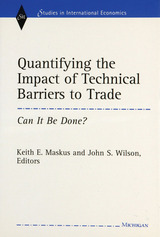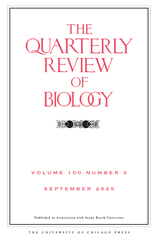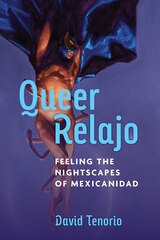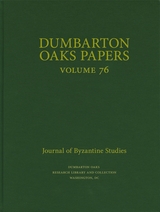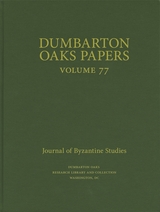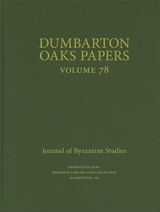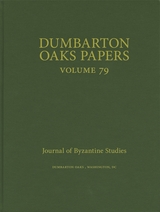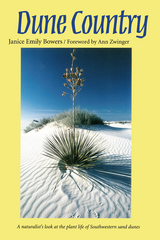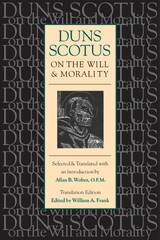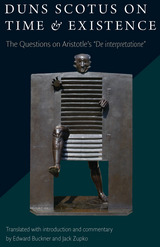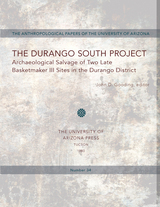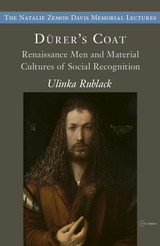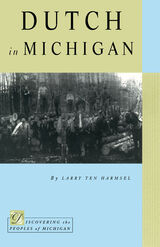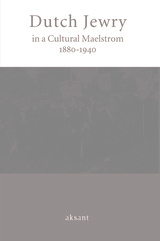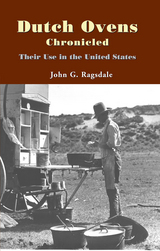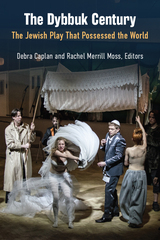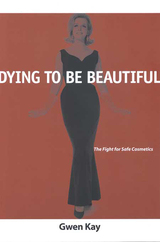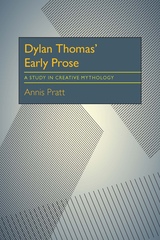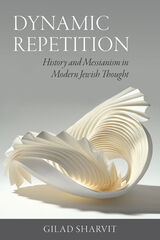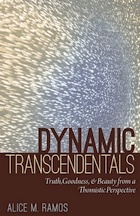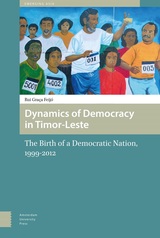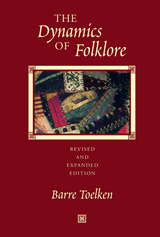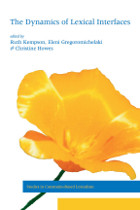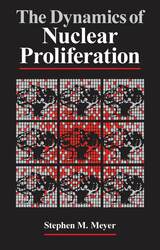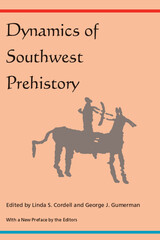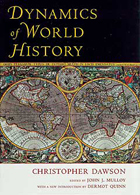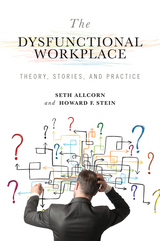Dumbarton Oaks Conference on Chavín
Elizabeth P. Benson
Harvard University Press The essays in Dumbarton Oaks Conference on Chavín were presented at a conference held at Dumbarton Oaks in October 1968. As the earliest civilization in Andes, Chavín had an undeniable influence on later cultures. Carefully collated and expertly edited by Elizabeth P. Benson and published in 1971, these essays explore ideas regarding the origin, rise, and spread of the Chavín culture throughout Andean South America.
The papers in this conference were concerned with the possible origins of Chavín civilization and its spread to other regions. Chavín, the earliest civilization in Peru, with its great ceremonial center in the northern highlands, spread to the north coast and as far south as the Nasca Valley. Its influence is clear, but its origins are unknown, as is the nature of its diffusion.
Dumbarton Oaks Conference on the Olmec
Elizabeth P. Benson
Harvard University Press Arising from the first comprehensive conference on the Olmec since the famed Mesa Redonda in Tuxtla Gutierrez in 1942, Dumbarton Oaks Conference on the Olmec focuses on then-current archaeological work on the Olmec and discusses many important theoretical problems in the study of Olmec civilization. Papers range in subject matter from sculptural art at the San Lorenzo site to Olmec influence in the State of Morelos, Mexico, through commercial trade routes. In considering the problematic developments and ramifications of Olmec civilization, this volume offers an invigorating deep dive into the Olmec and remains an important text in the study of this ancient culture.
 The Dumbarton Oaks Conversations and the United Nations, 1944–1994
Ernest R. May
Harvard University Press, 1998 In 1944, as the end of World War II approached, an important series of talks were held to plan the formation of postwar international institutions. The meetings, which included debates on a variety of issues, were a first step toward the creation of the United Nations, whose establishment followed some months after. The site for the conversations was Dumbarton Oaks in Washington, D.C., a research institute administered by Harvard University.
In 1994, the “Dumbarton Oaks Conference, 1944–1994” brought together scholars and policymakers who had studied international organizations or had played important roles in them. A half century later, the world had evolved in ways that would have been unimaginable to many attendees of either the original conversations or the conference. This reissue of the conference proceedings, coinciding with the seventy-fifth anniversary of the United Nations in 2020, may assist readers who wish to familiarize themselves with the conditions that motivated the meetings in 1944.
Dumbarton Oaks Papers, 28
Dumbarton Oaks
Harvard University Press The annual journal Dumbarton Oaks Papers was founded in 1941 for the publication of articles relating to late antique, early medieval, and Byzantine civilization in the fields of art and architecture, history, archeology, literature, theology, law, and the auxiliary disciplines. Numerous maps, tables, illustrations, and color plates provide supplementary information for many of the articles.
Dumbarton Oaks Papers, 30
Julia Warner
Harvard University Press The annual journal Dumbarton Oaks Papers was founded in 1941 for the publication of articles relating to late antique, early medieval, and Byzantine civilization in the fields of art and architecture, history, archeology, literature, theology, law, and the auxiliary disciplines. Numerous maps, tables, illustrations, and color plates provide supplementary information for many of the articles.
Dumbarton Oaks Papers, 32
Dumbarton Oaks
Harvard University Press The annual journal Dumbarton Oaks Papers was founded in 1941 for the publication of articles relating to late antique, early medieval, and Byzantine civilization in the fields of art and architecture, history, archeology, literature, theology, law, and the auxiliary disciplines. Numerous maps, tables, illustrations, and color plates provide supplementary information for many of the articles.
Dumbarton Oaks Papers, 33
Dumbarton Oaks
Harvard University Press The annual journal Dumbarton Oaks Papers was founded in 1941 for the publication of articles relating to late antique, early medieval, and Byzantine civilization in the fields of art and architecture, history, archeology, literature, theology, law, and the auxiliary disciplines. Numerous maps, tables, illustrations, and color plates provide supplementary information for many of the articles.
Dumbarton Oaks Papers, 34/35
Dumbarton Oaks
Harvard University Press The annual journal Dumbarton Oaks Papers was founded in 1941 for the publication of articles relating to late antique, early medieval, and Byzantine civilization in the fields of art and architecture, history, archeology, literature, theology, law, and the auxiliary disciplines. Numerous maps, tables, illustrations, and color plates provide supplementary information for many of the articles.
Dumbarton Oaks Papers, 37
Dumbarton Oaks
Harvard University Press The annual journal Dumbarton Oaks Papers was founded in 1941 for the publication of articles relating to late antique, early medieval, and Byzantine civilization in the fields of art and architecture, history, archeology, literature, theology, law, and the auxiliary disciplines. Numerous maps, tables, illustrations, and color plates provide supplementary information for many of the articles.
Dumbarton Oaks Papers, 40
Dumbarton Oaks
Harvard University Press The annual journal Dumbarton Oaks Papers was founded in 1941 for the publication of articles relating to late antique, early medieval, and Byzantine civilization in the fields of art and architecture, history, archeology, literature, theology, law, and the auxiliary disciplines. Numerous maps, tables, illustrations, and color plates provide supplementary information for many of the articles.
 Dumbarton Oaks Papers, 42
Dumbarton Oaks
Harvard University Press The annual journal Dumbarton Oaks Papers was founded in 1941 for the publication of articles relating to late antique, early medieval, and Byzantine civilization in the fields of art and architecture, history, archeology, literature, theology, law, and the auxiliary disciplines. Numerous maps, tables, illustrations, and color plates provide supplementary information for many of the articles.
In this issue: Kathleen Corrigan, “The Witness of John the Baptist on an Early Byzantine Icon in Kiev”; Ann Terry, “The Sculpture at the Cathedral of Eufrasius in Poreč”; Natalia Teteriatnikov, “Upper-Story Chapels near the Sanctuary in Churches of the Christian East”; Mark J. Johnson, “Toward a History of Theoderic’s Building Program”; Paul Magdalino, “The Bath of Leo the Wise and the ‘Macedonian Renaissance’ Revisited: Topography, Iconography, Ceremonial, Ideology”; Robert W. Edwards, “The Vale of Kola: A Final Preliminary Report on the Marchlands of Northeast Turkey”; Joseph D. C. Frendo, “History and Panegyric in the Age of Heraclius: The Literary Background to the Composition of the Histories of Theophylact Simocatta”; John Meyendorff, “Mount Athos in the Fourteenth Century: Spiritual and Intellectual Legacy”; Nicolas Oikonomides, “Mount Athos: Levels of Literacy”; and Robert F. Taft, S.J., “Mount Athos: A Late Chapter in the History of the Byzantine Rite.”
Dumbarton Oaks Papers, 43
Dumbarton Oaks
Harvard University Press The annual journal Dumbarton Oaks Papers was founded in 1941 for the publication of articles relating to late antique, early medieval, and Byzantine civilization in the fields of art and architecture, history, archeology, literature, theology, law, and the auxiliary disciplines. Numerous maps, tables, illustrations, and color plates provide supplementary information for many of the articles.
Dumbarton Oaks Papers, 44
Dumbarton Oaks
Harvard University Press The annual journal Dumbarton Oaks Papers was founded in 1941 for the publication of articles relating to late antique, early medieval, and Byzantine civilization in the fields of art and architecture, history, archeology, literature, theology, law, and the auxiliary disciplines. Numerous maps, tables, illustrations, and color plates provide supplementary information for many of the articles.
Dumbarton Oaks Papers, 49
Dumbarton Oaks
Harvard University Press The annual journal Dumbarton Oaks Papers was founded in 1941 for the publication of articles relating to late antique, early medieval, and Byzantine civilization in the fields of art and architecture, history, archeology, literature, theology, law, and the auxiliary disciplines. Numerous maps, tables, illustrations, and color plates provide supplementary information for many of the articles.
Dumbarton Oaks Papers, 50
Dumbarton Oaks
Harvard University Press The annual journal Dumbarton Oaks Papers was founded in 1941 for the publication of articles relating to late antique, early medieval, and Byzantine civilization in the fields of art and architecture, history, archeology, literature, theology, law, and the auxiliary disciplines. Numerous maps, tables, illustrations, and color plates provide supplementary information for many of the articles.
Dumbarton Oaks Papers, 51
Dumbarton Oaks
Harvard University Press The annual journal Dumbarton Oaks Papers was founded in 1941 for the publication of articles relating to late antique, early medieval, and Byzantine civilization in the fields of art and architecture, history, archeology, literature, theology, law, and the auxiliary disciplines. Numerous maps, tables, illustrations, and color plates provide supplementary information for many of the articles.
Dumbarton Oaks Papers, 52
Dumbarton Oaks
Harvard University Press The annual journal Dumbarton Oaks Papers was founded in 1941 for the publication of articles relating to late antique, early medieval, and Byzantine civilization in the fields of art and architecture, history, archeology, literature, theology, law, and the auxiliary disciplines. Numerous maps, tables, illustrations, and color plates provide supplementary information for many of the articles.
Dumbarton Oaks Papers, 53
Dumbarton Oaks
Harvard University Press The annual journal Dumbarton Oaks Papers was founded in 1941 for the publication of articles relating to late antique, early medieval, and Byzantine civilization in the fields of art and architecture, history, archeology, literature, theology, law, and the auxiliary disciplines. Numerous maps, tables, illustrations, and color plates provide supplementary information for many of the articles.
Dumbarton Oaks Papers, 54
Dumbarton Oaks
Harvard University Press The annual journal Dumbarton Oaks Papers was founded in 1941 for the publication of articles relating to late antique, early medieval, and Byzantine civilization in the fields of art and architecture, history, archeology, literature, theology, law, and the auxiliary disciplines. Numerous maps, tables, illustrations, and color plates provide supplementary information for many of the articles.
Dumbarton Oaks Papers, 55
Dumbarton Oaks
Harvard University Press The annual journal Dumbarton Oaks Papers was founded in 1941 for the publication of articles relating to late antique, early medieval, and Byzantine civilization in the fields of art and architecture, history, archeology, literature, theology, law, and the auxiliary disciplines. Numerous maps, tables, illustrations, and color plates provide supplementary information for many of the articles.
Dumbarton Oaks Papers, 56
Dumbarton Oaks
Harvard University Press The annual journal Dumbarton Oaks Papers was founded in 1941 for the publication of articles relating to late antique, early medieval, and Byzantine civilization in the fields of art and architecture, history, archeology, literature, theology, law, and the auxiliary disciplines. Numerous maps, tables, illustrations, and color plates provide supplementary information for many of the articles.
Dumbarton Oaks Papers, 57
Dumbarton Oaks
Harvard University Press The annual journal Dumbarton Oaks Papers was founded in 1941 for the publication of articles relating to late antique, early medieval, and Byzantine civilization in the fields of art and architecture, history, archeology, literature, theology, law, and the auxiliary disciplines. Numerous maps, tables, illustrations, and color plates provide supplementary information for many of the articles.
Dumbarton Oaks Papers, 58
Alice-Mary Talbot
Harvard University Press The annual journal Dumbarton Oaks Papers was founded in 1941 for the publication of articles relating to late antique, early medieval, and Byzantine civilization in the fields of art and architecture, history, archeology, literature, theology, law, and the auxiliary disciplines. Numerous maps, tables, illustrations, and color plates provide supplementary information for many of the articles.
Dumbarton Oaks Papers, 59
Alice-Mary Talbot
Harvard University Press Dumbarton Oaks Papers is an annual journal of scholarly articles on Byzantine topics. Many of the articles are based upon presentations made at the Byzantine conferences hosted by Dumbarton Oaks. Numerous maps, tables, illustrations, and color plates provide supplementary information.
Dumbarton Oaks Papers 59 includes papers from a colloquium on Byzantine glass, guest edited by David Whitehouse of the Corning Museum of Glass. Other articles feature a discussion of zodiac cycles in ancient Palestinian synagogues, a study of early Christians' responses to the spectacles of fifth-century Carthage, and an analysis of scientific and literary sources pertaining to the mysterious cloud that darkened the sky for about a year in 536, to determine what, if any, immediate effects it had. A fieldwork report on the ongoing excavations at the Amorium project is also featured.
Dumbarton Oaks Papers, 60
Alice-Mary Talbot
Harvard University Press Volume 60 of this annual journal explores a range of Byzantine subjects: the classification of stamping objects (including six previously unpublished metal stamps); the date and purpose of the construction of Constantinople’s church of Saints Sergius and Bacchus; the Coptic Church’s literary construction of its identity in post-conquest Egypt; the evidence for the tenth-century revision of the so-called Chronicle of 811; an unusual development in the iconography of St. Menas; and versions of Niketas Choniates’ History.
Also included are editions and translations of Byzantine Communion prayers newly discovered in Massachusetts and two funerary epigrams written by Manuel Philes; both articles include commentary. The volume concludes with reports from 2003 and 2004 on Dumbarton Oaks–supported archaeological fieldwork projects on a church in Bizye and an aristocratic rock-cut Byzantine settlement in Cappadocia.
Dumbarton Oaks Papers, 61
Alice-Mary Talbot
Harvard University Press This latest volume of Dumbarton Oaks Papers focuses in part on literary and historical texts: historicism in Byzantine thought and literature; the Chronicle of Matthew of Edessa, encompassing the First Crusade and the Armenian diaspora; and a reappraisal of the satirical prose work Mazaris’s Journey to Hades. The history and architecture of the Cypriot Monastery of Saint John Chrysostomos at Koutsovendis occupy a lengthy and informative chapter, which also includes a first edition of the “Letter of Nikon of the Black Mountain to the Founder George.”
The volume also contains selected papers from the 2005 Dumbarton Oaks symposium on the archaeological evidence for settlement patterns in Anatolia and the Levant between 500 and 1000.
Dumbarton Oaks Papers, 62
Alice-Mary Talbot
Harvard University Press This volume begins with a substantial investigation of the murder of several members of the imperial family during the summer of 337, following the death of Constantine. Two other major articles are devoted to well-known Byzantine illustrated manuscripts, the ninth-century Sacra Parallela and the fourteenth-century collection of theological works by the emperor John VI Kantakouzenos, both now in Paris. A third art-historical paper presents a detailed analysis of the architectural decoration of the church of the “Red Monastery” near Suhag in Egypt. Other studies treat the mystery of the Incarnation as well as the earliest version of the Life of the Virgin and its relationship with the cult of Marian relics in Constantinople.
The volume concludes with three papers from a colloquium on the hymnographer Romanos the Melode.
 Dumbarton Oaks Papers, 63
Alice-Mary Talbot
Harvard University Press Founded in 1941, the annual journal Dumbarton Oaks Papers is dedicated to the publication of articles relating to late antique, early medieval, and Byzantine civilization in the fields of art and architecture, history, archaeology, literature, theology, law, and auxiliary disciplines.
In this issue: Alexander Sarantis, “War and Diplomacy in Pannonia and the Northwest Balkans during the Reign of Justinian: The Gepid Threat and Imperial Responses”; Peter Hatlie, “Images of Motherhood and Self in Byzantine Literature”; Maria Evangelatou, “Liturgy and the Illustration of the Ninth-Century Marginal Psalters”; Henry Maguire, “Ivories as Pilgrimage Art: A New Frame for the ‘Frame Group’”; Vasileios Marinis, “Tombs and Burials in the Monastery tou Libos in Constantinople”; and three fieldwork reports: “Second Report on the Excavation in the Monastery of Apa Shenute (Dayr Anba Shinuda) at Suhag,” by Peter Grossman, Darlene L. Brooks Hedstrom, and Saad Mohamad Mohamad Osman, with a contribution by Hans-Christoph Noeske; “To Live and Die in a Turbulent Era: Bioarchaeological Analysis of the Early Byzantine (6th–7th Centuries AD) Population from Sourtara Galaniou Kozanis (Northern Greece),” by Chryssi Bourbou; and “Study and Restoration of the Zeyrek Camii in Istanbul: Second Report, 2001–2005,” by Robert Ousterhout, Zeynep Ahunbay, and Metin Ahunbay.
 Dumbarton Oaks Papers, 64
Margaret Mullett
Harvard University Press This issue includes “Apostolic Geography: The Origins and Continuity of a Hagiographic Habit” (Scott Fitzgerald Johnson); “John Lydus and His Contemporaries on Identities and Cultures of Sixth-Century Byzantium” (Sviatoslav Dmitriev); “Grotesque Bodies in Hagiographical Tales: The Monstrous and the Uncanny in Byzantine Collections of Miracle Stories” (Stavroula Constantinou); “Byzantine Political Culture and Compilation Literature in the Tenth and Eleventh Centuries: Some Preliminary Inquiries” (Catherine Holmes); “Byzantine Mirrors: Self-Reflection in Medieval Greek Writing” (Stratis Papaioannou); “Transformative Narratives and Shifting Identities in the Narthex of the Boiana Church” (Rossitza B. Schroeder); “Tracing Monastic Economic Interests and Their Impact on the Rural Landscape of Late Byzantine Lemnos” (Fotini Kondyli); “The Imperial Image at the End of Exile: The Byzantine Embroidered Silk in Genoa and the Treaty of Nymphaion (1261)” (Cecily J. Hilsdale); “A Byzantine Text on the Technique of Icon Painting” (Georgi R. Parpulov, Irina V. Dolgikh, and Peter Cowe); and “New Archaeology at Ancient Scetis: Surveys and Initial Excavations at the Monastery of St. John the Little in Wādī al-Naṭrūn” (Darlene Brooks Hedstrom with Stephen J. Davis, Tomasz Herbich, Salima Ikram, Dawn McCormack, Marie-Dominique Nenna, and Gillian Pyke).
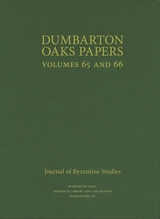 Dumbarton Oaks Papers, 65/66
Margaret Mullett
Harvard University Press This issue includes “Bishops and Territory: The Case of Late Roman and Byzantine North Africa” (Anna Leone); “A Conflicted Heritage: The Byzantine Religious Establishment of a War Ethic” (J. A. McGuckin); “Hoards and Hoarding Patterns in the Early Byzantine Balkans” (Florin Curta and Andrei Gândilă); “Light, Color, and Visual Illusion in the Poetry of Venantius Fortunatus” (Michael Roberts); “At the Edge of Two Empires: The Economy of Cyprus between Late Antiquity and the Early Middle Ages (650s–800s CE)” (Luca Zavagno); “China, Byzantium, and the Shadow of the Steppe” (David A. Graff); “‘And So, with the Help of God’: The Byzantine Art of War in the Tenth Century” (Robert S. Nelson); “The Image of the Virgin Nursing (Galaktotrophousa) and a Unique Inscription on the Seals of Romanos, Metropolitan of Kyzikos” (John Cotsonis); “Marching across Anatolia: Medieval Logistics and Modeling the Mantzikert Campaign” (John Haldon with Vince Gaffney, Georgios Theodoropoulos, and Phil Murgatroyd); “The Moral Pieces by Theodore II Laskaris” (Dimiter G. Angelov); “Mary Magdalene between East and West: Cult and Image, Relics and Politics in the Late Thirteenth-Century Eastern Mediterranean” (Vassiliki A. Foskolou); “Byzantine Houses and Modern Fictions: Domesticating Mystras in 1930s Greece” (Kostis Kourelis); and “The White Monastery Federation Project: Survey and Mapping at the Monastery of Apa Shenoute (Dayr al-Anba Shinūda), Sohag, 2005–2007” (Darlene L. Brooks Hedstrom and Elizabeth S. Bolman with Mohammed Abdel Rahim, Saad Mohammed, Dawn McCormack, Tomasz Herbich, Gillian Pyke, Louise Blanke, Tracy Musacchio, and Mohammed Khalifa).
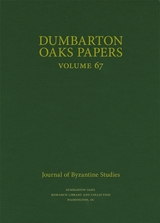 Dumbarton Oaks Papers, 67
Margaret Mullett
Harvard University Press Founded in 1941, the annual journal Dumbarton Oaks Papers is dedicated to the publication of articles relating to late antique, early medieval, and Byzantine civilization in the fields of art and architecture, history, archaeology, literature, theology, law, and auxiliary disciplines.
This issue includes “The Canon Tables of the Psalms: An Unknown Work of Eusebius of Caesarea” by Martin Wallraff; “Histoires ‘Gothiques’ à Byzance: Le Saint, Le Soldat, et Le Miracle d’Euphémie et du Goth (BHG 739)” by Charis Messis and Stratis Papaioannou; “Reassessing the Sarcophagi of Ravenna” by Edward M. Schoolman; “Sources for the Study of Liturgy in Post-Byzantine Jerusalem (638–1187 CE)” by Daniel Galadza; “(Re)Mapping Medieval Antioch: Urban Transformations from the Early Islamic to the Middle Byzantine Periods” by A. Asa Eger; “Melkites and Icon Worship during the Iconoclastic Period” by Juan Signes Codoñer; “The Anzas Family: Members of the Byzantine Civil Establishment in the Eleventh, Twelfth, and Thirteenth Centuries” by John Nesbitt and Werner Seibt; “Viewing and Description in Hysmine and Hysminias: The Fresco of the Virtues” by Paroma Chatterjee; “The Documents of Dominicus Grimani, Notary in Candia (1356–1357)” by Nicky Tsougarakis; and “The Church of Saints Sergius and Bacchus in Kaftūn (Northern Lebanon) and Its Wall Paintings” by Tomasz Waliszewski, Krzysztof Chmielewski, Mat Immerzeel, and Nada Hélou.
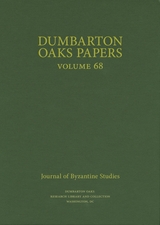 Dumbarton Oaks Papers, 68
Margaret Mullett
Harvard University Press This issue includes “Exiling Bishops: The Policy of Constantius II,” by Walt Stevenson; “In Search of Monotheletism,” by Jack Tannous; “The Archaeology and Reconstruction of Zuartʿnocʿ,” by Christina Maranci; “The South Vestibule of Hagia Sophia at Istanbul: The Ornamental Mosaics and the Private Door of the Patriarchate,” by Philipp Niewöhner and Natalia Teteriatnikov; “Reality and Invention: Reflections on Byzantine Historiography,” by Ralph-Johannes Lilie; “An Enigmatic Literature: Interpreting an Unedited Collection of Byzantine Riddles in a Manuscript of Cardinal Bessarion (Marcianus Graecus 512),” by Simone Beta; “Threads of Power: Clothing Symbolism, Human Salvation, and Female Identity in the Illustrated Homilies by Iakobos of Kokkinobaphos,” by Maria Evangelatou; “The Byzantino-Latin Principality of Adrianople and the Challenge of Feudalism (1204/6–ca. 1227/28): Empire, Venice, and Local Autonomy,” by Filip Van Tricht; “The Image of the Virgin on the Sinai Hexaptych and the Apse Mosaic of Hagia Sophia, Constantinople,” by Zaza Skhirtladze; “Odd Surnames Beginning with Alpha: A Selection of Examples on Byzantine Seals in the Harvard Collections,” by Werner Seibt and John Nesbitt; “The Miniatures in the Rabbula Gospels: Postscripta to a Recent Book,” by Massimo Bernabò; and “Fieldwork Report: Results of the Tophane Area GPR Surveys, Bursa, Turkey,” by Suna Çağaptay with April Kamp-Whittaker and Lawrence Conyers.
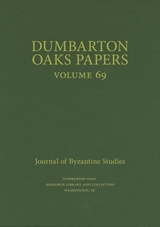 Dumbarton Oaks Papers, 69
Margaret Mullett
Harvard University Press In this issue: Jeffrey Wickes, “Mapping the Literary Landscape of Ephrem’s Theology of Divine Names”; Örgü Dalgıç, “The Triumph of Dionysos in Constantinople”; Lain Wilson, “A Subaltern’s Fate”; Antony Eastmond, “The Heavenly Court, Courtly Ceremony, and the Great Byzantine Ivory Triptychs of the Tenth Century”; Timothy Greenwood, “A Corpus of Early Medieval Armenian Silver” (with an Appendix, “Carbunculus ardens: The Garnet on the Narses Cross in Context,” by Noël Adams); Stefanos Alexopoulos, “When a Column Speaks”; Floris Bernard, “Humor in Byzantine Letters of the Tenth to Twelfth Centuries”; Angelina Anne Volkoff, “Komnenian Double Surnames on Lead Seals”; Margaret Alexiou, “Of Longings and Loves”; Panagiotis A. Agapitos, “Literary Haute Cuisine and Its Dangers”; Niels Gaul, “Writing ‘with Joyful and Leaping Soul’”; Natalia Teteriatnikov, “The Last Palaiologan Mosaic Program of Hagia Sophia”; Jonathan Shea, “Longuet’s ‘Salonica Hoard’ and the Mint of Thessalonike in the Mid-Fourteenth Century”; Tera Lee Hedrick and Nina Ergin, “A Shared Culture of Heavenly Fragrance”; and Mark Jackson, “2007–2011 Excavations at Kilise Tepe.”
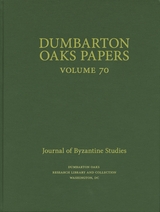 Dumbarton Oaks Papers, 70
Margaret Mullett
Harvard University Press In this issue: Roland Betancourt, “Why Sight Is Not Touch: Reconsidering the Tactility of Vision in Byzantium”; Byron MacDougall, “Gregory Thaumaturgus: A Platonic Lawgiver”; Scott Fitzgerald Johnson, “‘The Stone the Builders Rejected’: Liturgical and Exegetical Irrelevancies in the Piacenza Pilgrim”; Nicholas Warner, “The Architecture of the Red Monastery Church (Dayr Anbā Bišūy) in Egypt: An Evolving Anatomy”; Ilene H. Forsyth with Elizabeth Sears, “George H. Forsyth and the Sacred Fortress at Sinai”; Heta Björklund, “Classical Traces of Metamorphosis in the Byzantine Hystera Formula”; Anne-Laurence Caudano, “‘These Are the Only Four Seas’: The World Map of Bologna, University Library, Codex 3632”; Charis Messis, “Les voix littéraires des eunuques: Genre et identité du soi à Byzance”; Przemysław Marciniak, “Reinventing Lucian in Byzantium”; Aglae Pizzone, “Audiences and Emotions in Eustathios of Thessalonike’s Commentaries on Homer”; Niels Gaul, “All the Emperor’s Men (and His Nephews): Paideia and Networking Strategies at the Court of Andronikos II Palaiologos, 1290–1320”; Christopher Wright, “Constantinople and the Coup d’État in Palaiologan Byzantium”; and Nadezhda Kavrus-Hoffmann, “A Newly Acquired Gospel Manuscript at Dumbarton Oaks (DO MS 5): Codicological and Paleographic Description and Analysis.”
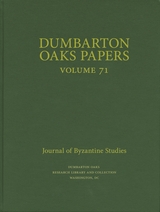 Dumbarton Oaks Papers, 71
Elena Boeck
Harvard University Press In this issue: Maya Maskarinec, “Saints for All Christendom: Naturalizing the Alexandrian Saints Cyrus and John in Seventh- to Thirteenth-Century Rome”; Joe Glynias, “Prayerful Iconoclasts: Psalm Seals and Elite Formation in the First Iconoclast Era (726–750)”; Jordan Pickett, “Water and Empire in the De Aedificiis of Procopius”; Florin Leonte, “Visions of Empire: Gaze, Space, and Territory in Isidore’s Encomium for John VIII Palaiologos”; Anastasia Drandaki, “Piety, Politics, and Art in Fifteenth-Century Venetian Crete”; Julian Baker, Filippo Dompieri, and Turan Gökyildirim with Kelly Domoney, Tuğçe Pamuk, and Irmak Güneş Yüceil, “The Reformed Byzantine Silver-Based Currencies (ca. 1372–1379) in the Light of the Hoards from the Belgrade Gate”; Vasileios Marinis, “The Vision of Last Judgment in the Vita of Saint Niphon (BHG 1371z)”; Daniel Reynolds, “Rethinking Palestinian Iconoclasm”; Athanasios K. Vionis, “Understanding Settlements in Byzantine Greece: New Data and Approaches for Boeotia, Sixth to Thirteenth Century”; Nikos Zagklas, “Experimenting with Prose and Verse in Twelfth-Century Byzantium: A Preliminary Study”; and Christophe Erismann, “Theodore the Studite and Photius on the Humanity of Christ: A Neglected Byzantine Discussion on Universals in the Time of Iconoclasm.”
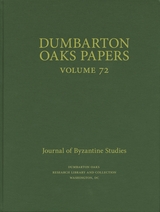 Dumbarton Oaks Papers, 72
Elena Boeck
Harvard University Press Published annually, the journal Dumbarton Oaks Papers was founded in 1941 for the publication of articles relating to Byzantine civilization.
In this issue: Audrey Becker, “Verbal and Nonverbal Diplomatic Communication at the Imperial Court of Constantinople (fifth–sixth Centuries)”; Alexandra Wassiliou-Seibt and Andreas Gkoutzioukostas, “The Origin and the Members of the Kamytzes Family: A Contribution to Byzantine Prosopography”; Michael Zellmann-Rohrer, “‘Psalms Useful for Everything’: Byzantine and Post-Byzantine Manuals for the Amuletic Use of the Psalter”; Raymond Van Dam, “Eastern Aristocracies and Imperial Courts: Constantine’s Half-Brother, Licinius’s Prefect, and Egyptian Grain”; Daniel Caner, “Not a Hospital but a Leprosarium: Basil’s Basilias and an Early Byzantine Concept of the Deserving Poor”; Paul Botley, “Greek Literature in Exile: The Books of Andronicus Callistus, 1475–1476”; Aude Busine, “The Dux and the Nun: Hagiography and the Cult of Artemios and Febronia in Constantinople”; Benjamin Garstad, “Dionysiac and Christian Elements in the Lysos Episode in the Greek Alexander Romance (β rec.).”
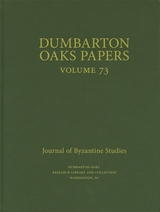 Dumbarton Oaks Papers, 73
Joel Kalvesmaki
Harvard University Press Published annually, the journal Dumbarton Oaks Papers was founded in 1941 for the publication of articles relating to Byzantine civilization.
In this issue: Walter E. Kaegi, “Irfan Shahîd (1926–2016)”; Daniel Galadza, “Robert F. Taft, S.J. (1932–2018)”; Sylvain Destephen, “From Mobile Center to Constantinople: The Birth of Byzantine Imperial Government”; Dina Boero, “Making a Manuscript, Making a Cult: Scribal Production of the Syriac Life of Symeon the Stylite in Late Antiquity”; Alexandre M. Roberts, “Framing a Middle Byzantine Alchemical Codex”; Lilia Campana, “Sailing into Union: The Byzantine Naval Convoy for the Council of Ferrara–Florence (1438–1439)”; Hugh G. Jeffery, “New Lead Seals from Aphrodisias”; Maria G. Parani, “Curtains in the Middle and Late Byzantine House”; Kostis Kourelis, “Wool and Rubble Walls: Domestic Archaeology in the Medieval Peloponnese”; Kathrin Colburn, “Loops, Tabs, and Reinforced Edges: Evidence for Textiles as Architectural Elements”; Eunice Dauterman Maguire, “Curtains at the Threshold: How They Hung and How They Performed”; Sabine Schrenk, “The Background of the Enthroned: Spatial Analysis of the Hanging with Hestia Polyolbos in the Dumbarton Oaks Collection”; Jennifer L. Ball, “Rich Interiors: The Remnant of a Hanging from Late Antique Egypt in the Collection of Dumbarton Oaks”; Maria Evangelatou, “Textile Mediation in Late Byzantine Visual Culture: Unveiling Layers of Meaning through the Fabrics of the Chora Monastery”; Thelma K. Thomas, “The Honorific Mantle as Furnishing for the Household Memory Theater in Late Antiquity: A Case Study from the Monastery of Apa Apollo at Bawit”; Avinoam Shalem, “‘The Nation Has Put On Garments of Blood’: An Early Islamic Red Silken Tapestry in Split”; and Elizabeth Dospěl Williams, “A Taste for Textiles: Designing Ummayad and Early ʿAbbāsid Interiors.”
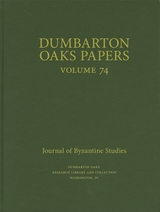 Dumbarton Oaks Papers, 74
Colin M. Whiting
Harvard University Press Published annually, the journal Dumbarton Oaks Papers was founded in 1941 for the publication of articles relating to Byzantine civilization.
In this issue: John S. Langdon and Stephen W. Reinert, “Speros Vryonis Jr.: 1928–2019”; Abraham Terian, “Monastic Turmoil in Sixth-Century Jerusalem and the South Caucasus: The Letter of Patriarch John IV to Catholicos Abas of the Caucasian Albanians”; Coleman Connelly, “Continued Celebration of the Kalends of January in the Medieval Islamic East”; Victoria Gerhold, “The Legend of Euphratas: Some Notes on Its Origins, Development, and Significance”; Christos Simelidis, “Two Lives of the Virgin: John Geometres, Euthymios the Athonite, and Maximos the Confessor”; Georgios Makris, “Living in Turbulent Times: Monasteries, Settlements, and Laypeople in Late Byzantine Southwest Thrace”; Philipp Niewöhner, “The Significance of the Cross before, during, and after Iconoclasm: Early Christian Aniconism in Constantinople and Asia Minor”; Stefania Gerevini, “Art as Politics in the Baptistery and Chapel of Sant’Isidoro at San Marco, Venice”; Laura Pfuntner, “Between Science and Superstition: Photius, Diodorus Siculus, and ‘Hermaphrodites’”; Baukje van den Berg, “John Tzetzes as Didactic Poet and Learned Grammarian”; Matthew Kinloch, “In the Name of the Father, the Husband, or Some Other Man: The Subordination of Female Characters in Byzantine Historiography”; Levente László, “Rhetorius, Zeno’s Astrologer, and a Sixth-Century Astrological Compendium”; and Stig Simeon R. Frøyshov, “The Early History of the Hagiopolitan Daily Office in Constantinople: New Perspectives on the Formative Period of the Byzantine Rite.”
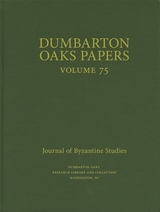 Dumbarton Oaks Papers, 75
Colin M. Whiting
Harvard University Press Published annually, the journal Dumbarton Oaks Papers was founded in 1941 for the publication of articles relating to Byzantine civilization.
In this issue: Margaret Mullet, “Ruth Juliana Macrides: 1949–2019”; Sihong Lin, “Justin under Justinian: The Rise of Emperor Justin II Revisited”; David Gyllenhaal, “Byzantine Melitene and the Social Milieu of the Syriac Renaissance”; Pavel Murdzhev, “The Introduction of the Moldboard Plow to Byzantine Thrace in the Eleventh Century”; Annemarie Weyl Carr, “The Lady and the Juggler: Mary East and West”; Robert S. Nelson, “A Miniature Mosaic Icon of St. Demetrios in Byzantium and the Renaissance”; Esra Akin-Kivanç, “In the Mirror of the Other: Imprints of Muslim–Christian Encounters in the Late Antique and Early Medieval Mediterranean”; Anna Chrysostomides, “John of Damascus’s Theology of Icons in the Context of Eighth-Century Palestinian Iconoclasm”; Max Ritter, “The Byzantine Afterlife of Procopius’s Buildings”; Jonathan L. Zecher, “Myths of Aerial Tollhouses and Their Tradition from George the Monk to the Life of Basil the Younger”; Nektarios Zarras, “Illness and Healing: Τhe Ministry Cycle in the Chora Monastery and the Literary Oeuvre of Theodore Metochites”; and Aleksandr Andreev, “The Order of the Hours in the Yaroslavl Horologion.”
Dumbarton Oaks Papers, 76
Colin M. Whiting
Harvard University Press Published annually, the journal Dumbarton Oaks Papers was founded in 1941 for the publication of articles relating to Byzantine civilization. Volume 76 includes articles on the law under Alexios I, politics under Manuel I, the economies of the major Mediterranean islands, the literature of Niketas Choniates, the trial of John bar ʿAbdun, and more.
Dumbarton Oaks Papers, 77
Colin M. Whiting and Nikos D. Kontogiannis
Harvard University Press Published annually, the journal Dumbarton Oaks Papers was founded in 1941 for the publication of articles relating to Byzantine civilization. Volume 77 includes articles on Byzantine insects, wine production and consumption in Anatolia, the Huqoq elephant mosaic, and more.
Dumbarton Oaks Papers, 78
Colin M. Whiting and Nikos D. Kontogiannis
Harvard University Press Dumbarton Oaks Papers is one of the world’s preeminent journals in the field of Byzantine Studies. Published annually since 1941 and now available open access, its articles cover all aspects of society, culture, and art from roughly the fourth through the fifteenth century in the Roman Empire and in successor and neighboring states. Readers will find sophisticated and innovative studies that engage with questions of history, literature, and theology; a wide range of artistic expression; and archaeological and other material remains.
Volume 78 includes articles on authors like Agathias, Theophanes of Nicaea, and Gemistos Pletho; subjects like Byzantine medicine, the concept of “just war,” and early canonical collections; and more.
Dumbarton Oaks Papers, 79
Colin M. Whiting and Nikos D. Kontogiannis
Harvard University Press Dumbarton Oaks Papers is one of the world’s preeminent journals in the field of Byzantine Studies. Published annually since 1941 and now available open access, its articles cover all aspects of society, culture, and art from roughly the fourth through the fifteenth century in the Roman Empire and in successor and neighboring states. Readers will find sophisticated and innovative studies that engage with questions of history, literature, and theology; a wide range of artistic expression; and archaeological and other material remains. Dumbarton Oaks Papers, 79 includes articles on Byzantine military manuals, Georgian miracle stories, Red Sea islands, and more.
 Dumbarton Oaks: The Collections
Gudrun Bühl
Harvard University Press, 2008 Dumbarton Oaks houses the extraordinary art collection begun by Mildred and Robert Woods Bliss. In this book the museum publishes the specialist collections in Byzantine and Pre-Columbian art, along with examples from the Blisses’ superb European collection, for the first time.
When Robert Bliss recalled handling a jade Olmec figurine in 1913, he said, “That day, the collector’s microbe took root in—it must be confessed—very fertile soil.” The Blisses’ passion for art bore fruit in a remarkably diverse collection: Flemish tapestries, Renaissance furniture, and paintings by the likes of El Greco, Renoir, and Degas. The celebrated Byzantine collection includes floor mosaics from late antique Antioch, sumptuous jewelry, carved ivory reliefs, liturgical silver, and a comprehensive coin and seals collection. The Pre-Columbian collection showcases fine jade carvings, gold jewelry, monumental sculpture, ritual weaponry, colorful ceramics, and intricately woven textiles.
The publication of this new guidebook coincides with the complete refurbishment of Dumbarton Oaks and the creative reinstallation of the galleries. The curators offer highlights of the collection, accompanied by a lucid and thought-provoking text. Dumbarton Oaks: The Collections is intended as a valuable resource and a pleasure to read for scholars and nonspecialists alike.
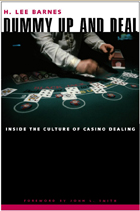 Dummy Up And Deal: Inside The Culture Of Casino Dealing
H. Lee Barnes
University of Nevada Press, 2011 The glitter and excitement that tourists associate with casinos is only a facade. To the gaming industry's front-line employees, its dealers, the casino is a far less glamorous environment, a workplace full of emotional tension, physical and mental demands, humor and pathos. Author H. Lee Barnes, who spent many years as a dealer in some of Las Vegas's best-known casinos, shows us this world from the point of view of the table-games dealer. Told in the voices of dozens of dealers, male and female, young and old, Dummy Up and Deal takes us to the dealer's side of the table. We observe the "breaking in" that constitutes a dealer's training, where the hands learn the motions of the game while the mind undergoes the requisite hardening to endure long hours of concentration and the demands of often unreasonable and sometimes abusive players. We discover how dealers are hired and assigned to shifts and tables, how they interact with each other and with their supervisors, and how they deal with players—the winners and the losers, the "Sweethearts" and the "Dragon Lady," the tourists looking for a few thrills and the mobsters showing off their "juice." We observe cheaters on both sides of the table and witness the exploits of such high-rollers as Frank Sinatra and Colonel Parker, Elvis's manager. And we learn about the dealers' lives after-hours, how some juggle casino work with family responsibilities while others embrace the bohemian lifestyle of the Strip and sometimes lose themselves to drugs, drink, or sex. It's a life that invites cynicism and bitterness, that can erode the soul and deaden the spirit. But the dealer's life can also offer moments of humor, encounters with generous and kindly players, moments of pride or humanity or professional solidarity. Barnes writes with the candor of a keen observer of his profession, someone who has seen it all—many times—but has never lost his capacity to wonder, to sympathize, or to laugh. Dummy Up and Deal is a colorful insider's view of the casino industry, a fascinating glimpse behind the glitter into the real world of the casino worker.
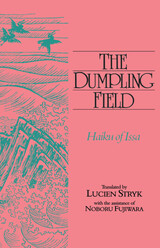 Dumpling Field: Haiku Of Issa
Koyashi Issa
Ohio University Press, 1991 Koyashi Issa (1763–1827), long considered amoung Japan’s four greatest haiku poets (along with Basho, Buson, and Shiki) is probably the best loved. This collection of more than 360 haiku, arranged seasonally and many rendered into English for the first time, attempts to reveal the full range of the poet’s extraordinary life as if it were concentrated within a year. Issa’s haiku are traditionally structured, of seventeen syllables in the original, tonally unified and highly suggestive, yet they differ from those of fellow haikuists in a few important respects. Given his character, they had to. The poet never tries to hide his feelings, and again and again we find him grieving over the lot of the unfortunate – of any and all species. No poet, of any time or culture, feels greater compassion for his life of creatures. No Buddhist-Issa was to become a monk—acts out the credos of his faith more genuinely. The poet, a devoted follower of Basho, traveled throughout the country, often doing the most menial work, seeking spiritual companionship and inspiration for the thousands of haiku he was to write. Yet his emotional and creative life was centered in his native place, Kashiwabara in the province of Shinano (now Nagano Prefecture), and his severest pain was the result of being denied a place in his dead father’s house by his stepmother and half brother. By the time he was able to share the house of his beloved father, Issa had experienced more than most the grief of living, and much more was to follow with the death of his wife and their four children. In the face of all he continued to write, celebrating passionately the lives of all that shared the world with him, all creatures, all humans. Small wonder that Issa is so greatly loved by his fellow poets throughout the world, and by poetry lovers of all ages.
Dune Country: A Hiker's Guide to the Indiana Dunes
Glenda L. Daniel
Ohio University Press, 1984 One of our nation’s newest parks stretches along Lake Michigan across 14 miles of windswept beach between Gary and Michigan City in Northern Indiana. Dune Country explains for the first time in terms everyone can understand why the plant and animal succession and the rich variety of natural habitats there are so unique. Now Daniel has added a section on the geology of the area so that hikers will be able to identify formations that can be seen on a field trip. In this revised edition, Daniel also includes guides to the 15 miles of new trails added to the National Lake Shore, which cover a variety of terrains—the dunes along the lake and inland along rivers, old dunes and marshlands. This new edition now has more than 75 drawings as well as maps and guides to over 45 miles of hiking trails in both the National Lake Shore and Indiana Dunes State Park.
Dune Country: A Naturalist's Look at the Plant Life of Southwestern Sand Dunes
Janice Emily Bowers
University of Arizona Press, 1998 Janice Emily Bowers takes readers from New Mexico’s White Sands to Utah’s Coral Pink Dunes to the Death Valley dunes of California and beyond. Beautifully written and illustrated, Dune Country is a perfect introduction to the fragile ecosystems of sand dunes.
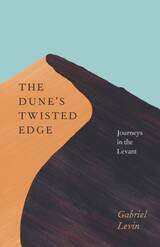 The Dune's Twisted Edge: Journeys in the Levant
Gabriel Levin
University of Chicago Press, 2012 “How to speak of the imaginative reach of a land habitually seen as a seedbed of faiths and heresies, confluences and ruptures . . . trouble spot and findspot, ruin and renewal, fault line and ragged clime, with a medley of people and languages once known with mingled affection and wariness as Levantine?” So begins poet Gabriel Levin in his journeys in the Levant, the exotic land that stands at the crossroads of western Asia, the eastern Mediterranean, and northeast Africa. Part travelogue, part field guide, and part literary appreciation, The Dune’s Twisted Edge assembles six interlinked essays that explore the eastern seaboard of the Levant and its deserts, bringing to life this small but enigmatic part of the world. Striking out from his home in Jerusalem in search of a poetics of the Fertile Crescent, Levin probes the real and imaginative terrain of the Levant, a place that beckoned to him as a source of wonder and self-renewal. His footloose travels take him to the Jordan Valley; to Wadi Rumm south of Petra; to the semiarid Negev of modern-day Israel and its Bedouin villages; and, in his recounting of the origins of Arabic poetry, to the Empty Quarter of Arabia where the pre-Islamic poets once roamed. His meanderings lead to encounters with a host of literary presences: the wandering poet-prince Imru al-Qays, Byzantine empress Eudocia, British naturalist Henry Baker Tristram, Herman Melville making his way to the Dead Sea, and even New York avant-garde poet Frank O’Hara. When he is not confronting ghosts, Levin finds himself stumbling upon the traces of vanished civilizations. He discovers a ruined Umayyad palace on the outskirts of Jericho, the Greco-Roman hot springs near the Sea of Galilee, and Nabatean stick figures carved on stones in the sands of Jordan. Vividly evoking the landscape, cultures, and poetry of this ancient region, The Dune’s Twisted Edge celebrates the contested ground of the Middle East as a place of compound myths and identities.
 Dunkirk: Fight to the Last Man
Hugh Sebag-Montefiore
Harvard University Press, 2006 In May of 1940, the armies of Nazi Germany were marching through France. In the face of this devastating advance, one of World War II’s greatest acts of heroism would be a retreat: the evacuation of the British Army from Dunkirk.
In Dunkirk: Fight to the Last Man, we are given an unprecedented vision of these harrowing days. Hugh Sebag-Montefiore has created a bold and powerful account of the small group of men who fended off the German army so that hundreds of thousands of their comrades could exit this doomed land. These brave troops, members of the British Expeditionary Forces and the French army, held a series of strong points inland, allowing the rest of the battered battalions to escape to the coast. Those that remained were ordered to fight to the last man.
Much has been written about the efforts of the Royal Navy in shuttling soldiers to safety, but here we are given an unparalleled look inside this massive operation and the invaluable role played by the BEF. Without the ferocity and bravery of the officers and ordinary soldiers on the ground, the German army would likely have encircled nearly half a million Allied soldiers. The loss of these battalions, Sebag-Montefiore argues, could have dramatically changed the direction of the war, and enabled Hitler to invade a weakened Britain.
This is military history at its best: a judicious analysis of the movement of the war, and a vivid feel of what it was like to be on the front line. Sebag-Montefiore brings these men—the forgotten heroes of Dunkirk—to life, and it is their valiant exploits and devotion to their brethren that form the heart of this important book.
 Dunmore's War: The Last Conflict of America's Colonial Era
Glenn F. Williams
Westholme Publishing, 2017 The War for the Ohio Country that Gave the Colonies the Critical Time to Debate and Declare Independence
Known to history as “Dunmore’s War,” the 1774 campaign against a Shawnee-led Indian confederacy in the Ohio Country marked the final time an American colonial militia took to the field in His Majesty’s service and under royal command. Led by John Murray, the fourth Earl of Dunmore and royal governor of Virginia, a force of colonials including George Rogers Clark, Daniel Morgan, Michael Cresap, Adam Stephen, and Andrew Lewis successfully enforced the western border established by treaties in parts of present-day West Virginia and Kentucky. The campaign is often neglected in histories, despite its major influence on the conduct of the Revolutionary War that followed. In Dunmore’s War: The Last Conflict of America’s Colonial Era, award-winning historian Glenn F. Williams describes the course and importance of this campaign. Supported by extensive primary source research, the author corrects much of the folklore concerning the war and frontier fighting in general, demonstrating that the Americans did not adopt Indian tactics for wilderness fighting as is often supposed, but rather used British methods developed for fighting irregulars in the woods of Europe, while incorporating certain techniques learned from the Indians and experience gained from earlier colonial wars.
As an immediate result of Dunmore’s War, the frontier remained quiet for two years, giving the colonies the critical time to debate and declare independence before Britain convinced its Indian allies to resume attacks on American settlements. Ironically, at the same time Virginia militiamen were fighting under command of a king’s officer, the colony was becoming one of the leaders in the move toward American independence. Although he was hailed as a hero at the end of the war, Lord Dunmore’s attempt to maintain royal authority put him in direct opposition to many of the subordinates who followed him on the frontier, and in 1776 he was driven from Virginia and returned to England.
Duns Scotus on Time and Existence
John Duns Scotus
Catholic University of America Press, 2014 An English translation of John Duns Scotus's The Questions on Aristotle's "De Interpretatione" including an extensive commentary on some of Scotus's more difficult ideas.
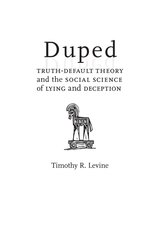 Duped: Truth-Default Theory and the Social Science of Lying and Deception
Timothy R. Levine
University of Alabama Press, 2020 A scrupulous account that overturns many commonplace notions about how we can best detect lies and falsehoods
From the advent of fake news to climate-science denial and Bernie Madoff’s appeal to investors, people can be astonishingly gullible. Some people appear authentic and sincere even when the facts discredit them, and many people fall victim to conspiracy theories and economic scams that should be dismissed as obviously ludicrous. This happens because of a near-universal human tendency to operate within a mindset that can be characterized as a “truth-default.” We uncritically accept most of the messages we receive as “honest.” We all are perceptually blind to deception. We are hardwired to be duped. The question is, can anything be done to militate against our vulnerability to deception without further eroding the trust in people and social institutions that we so desperately need in civil society?
Timothy R. Levine’s Duped: Truth-Default Theory and the Social Science of Lying and Deception recounts a decades-long program of empirical research that culminates in a new theory of deception—truth-default theory. This theory holds that the content of incoming communication is typically and uncritically accepted as true, and most of the time, this is good. Truth-default allows humans to function socially. Further, because most deception is enacted by a few prolific liars, the so called “truth-bias” is not really a bias after all. Passive belief makes us right most of the time, but the catch is that it also makes us vulnerable to occasional deceit.
Levine’s research on lie detection and truth-bias has produced many provocative new findings over the years. He has uncovered what makes some people more believable than others and has discovered several ways to improve lie-detection accuracy. In Duped, Levine details where these ideas came from, how they were tested, and how the findings combine to produce a coherent new understanding of human deception and deception detection.
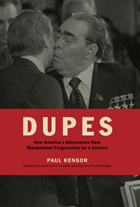 Dupes: How America's Adversaries Have Manipulated Progressives for a Century
Paul Kengor
Intercollegiate Studies Institute, 2010
In this startling, intensively researched book, bestselling historian Paul Kengor shines light on a deeply troubling aspect of American history: the prominent role of the “dupe.” From the Bolshevik Revolution through the Cold War and right up to the present, many progressives have unwittingly aided some of America’s most dangerous opponents.
Based on never-before-published FBI files, Soviet archives, and other primary sources, Dupes exposes the legions of liberals who have furthered the objectives of America’s adversaries. Kengor shows not only how such dupes contributed to history’s most destructive ideology—Communism, which claimed at least 100 million lives—but also why they are so relevant to today’s politics.
Dupes reveals:
• Shocking reports on how Senator Ted Kennedy secretly approached the Soviet leadership to undermine not one but two American presidents
• Stunning new evidence that Frank Marshall Davis—mentor to a young Barack Obama—had extensive Communist ties and demonized Democrats
• Jimmy Carter’s woeful record dealing with America’s two chief foes of the past century, Communism and Islamism
• Today’s dupes, including the congressmen whose overseas anti-American propaganda trip was allegedly financed by foreign intelligence
• How ’60s Marxist radicals—Tom Hayden, Mark Rudd, Jane Fonda, Jeff Jones, Bill Ayers, and more—have suddenly reemerged as “progressives for Obama”
• How Franklin Roosevelt was duped by “Uncle Joe” Stalin—and by a top adviser who may have been a Soviet agent—despite clear warnings from fellow Democrats
• How John Kerry’s accusations that American soldiers committed war crimes in Vietnam may have been the product of Soviet disinformation
• The many Hollywood stars who were duped, including Humphrey Bogart, Lauren Bacall, Katharine Hepburn, Gene Kelly—and even Ronald Reagan
• Soviet records that demonstrate beyond doubt the Communists’ expansionist aims and their targeting of American liberals, especially academics and the Religious Left
• How liberals still defend the same Communists who trashed Democratic icons like Woodrow Wilson, FDR, Harry Truman, and JFK—and still attack the anti-Communists who tried to spare them from manipulation
• Details on many other dupes (and dupers), including Arthur Miller, Dr. Benjamin Spock, John Dewey, H. G. Wells, George Bernard Shaw, Lillian Hellman, Howard Zinn, Walter Cronkite, and Helen Thomas
• A new chapter on the War on Terror.
Packed with stunning revelations, Dupes shows in frightening detail how U.S. adversaries exploit the American home front. Now with an updated introduction to the paperback edition.
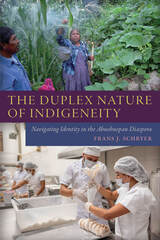 The Duplex Nature of Indigeneity: Navigating Identity in the Ahuehuepan Diaspora
Frans J. Schryer
University Press of Colorado, 2025 The Duplex Nature of Indigeneity is a detailed ethnography centered on Ahuehuepan, a Mexican town in the Alto Balsas region of the state of Guerrero, where an exodus of more than half the population to the United States and other parts of Mexico has altered both livelihoods and social identities. Frans Schryer traces the people, including families and descendants, who locate their identity in the Alto Balsas—a place some of them may never have seen.
Using a variety of sources, perspectives, and methods, Schryer takes a duplexity approach, which allows understanding the complexity of social reality and its complementary nature—it identifies fields, clusters, and layers as interconnected components of social life. The innovative methods consist of the combination of ethnographic description and an ethnohistorical census that provides information on every person going back to approximately 1850. That census is further examined with the use of inferential and non-inferential statistical techniques, archival research in locations not normally accessible to scholars, Facebook, phone interviews conducted over several years, and help from Nahuatl-speaking people whose perspectives on the findings generate additional information and insights.
Unique in this presentation, which dips into the lives of generations of people to draw insight on those who lay claim to transnational Indigeneity, Schryer’s work contributes to research and theoretical discussion in the field of migration and globalization studies through a close examination of one Indigenous community over the course of many years, utilizing a mix of qualitative and quantitative research methods in anthropology.
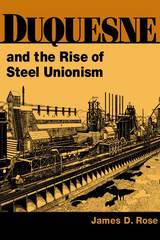 Duquesne and the Rise of Steel Unionism
James D. Rose
University of Illinois Press, 2001 Dismissed as a flimsy front for management interests, industrial unions nonetheless carved out a role in the Carnegie Steel Company empire and then at U.S. Steel. James D. Rose examines the pivotal role played by these company-sponsored employee representation plans (ERPs) at the legendary steel works in Duquesne, Pennsylvania. As Rose reveals, ERPs matured from tools of the company into worker-led organizations that represented the interests of the mills' skilled tradesmen and workers. ERPs and management created a sophisticated bargaining structure. Meanwhile, the independent trade union gave way to the Steel Workers Organizing Committee (SWOC), a professionalized organization that expended huge resources on companywide unionization. Yet even when the SWOC secured a collective bargaining agreement in 1937, it failed to sign up a majority of the Duquesne workforce. Sophisticated and persuasive, Duquesne and the Rise of Steel Unionism confirms that what people did on the shop floor played a critical role in the course of steel unionism.
The Durango South Project: Archaeological Salvage of Two Basketmaker III Sites in the Durango District
Edited by John D. Gooding
University of Arizona Press, 1980 The Anthropological Papers of the University of Arizona is a peer-reviewed monograph series sponsored by the School of Anthropology. Established in 1959, the series publishes archaeological and ethnographic papers that use contemporary method and theory to investigate problems of anthropological importance in the southwestern United States, Mexico, and related areas.
Dürer's Coats: Renaissance Men and Material Cultures of Social Recognition
Ulinka Rublack
Central European University Press, 2025 During the Renaissance, clothing became more and more elaborately decorated and expensive. It often emphasised the privilege of the male elite. Yet clothing could also subvert or reshape conventional cultural norms. Ulinka Rublack argues that cloaks and gowns gained in importance during this period and were among the things that mediated social relationships for centuries to come. An investigation into outerwear opens a new window into how people and things were connected in the Renaissance and how important clothing was in shaping subjectivities in everyday life. Using the example of Dürer and his wife as emerging social types, the study follows the artist and the men and women of his time through the streets of Venice, Nuremberg, Augsburg and Antwerp.
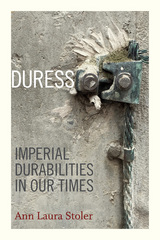 Duress: Imperial Durabilities in Our Times
Ann Laura Stoler
Duke University Press, 2016 How do colonial histories matter to the urgencies and conditions of our current world? How have those histories so often been rendered as leftovers, as "legacies" of a dead past rather than as active and violating forces in the world today? With precision and clarity, Ann Laura Stoler argues that recognizing "colonial presence" may have as much to do with how the connections between colonial histories and the present are expected to look as it does with how they are expected to be. In Duress, Stoler considers what methodological renovations might serve to write histories that yield neither to smooth continuities nor to abrupt epochal breaks. Capturing the uneven, recursive qualities of the visions and practices that imperial formations have animated, Stoler works through a set of conceptual and concrete reconsiderations that locate the political effects and practices that imperial projects produce: occluded histories, gradated sovereignties, affective security regimes, "new" racisms, bodily exposures, active debris, and carceral archipelagos of colony and camp that carve out the distribution of inequities and deep fault lines of duress today.
 Durham County: A History of Durham County, North Carolina
Jean Bradley Anderson
Duke University Press, 2011 In this revised and expanded second edition of Durham County, Jean Bradley Anderson extends her sweeping history of Durham from the seventeenth century to the end of the twentieth. Moving beyond traditional local histories, which tend to focus on powerful families, Anderson integrates the stories of well-known figures with those of ordinary men and women, blacks and whites, to create a complex and fascinating portrait of Durham’s economic, political, social, and labor history. Drawing on extensive primary research, she examines the origins of the town of Durham and recounts the growth of communities around mills, stores, taverns, and churches in the century before the rise of tobacco manufacturing. A historical narrative encompassing the coming of the railroad; the connection between the Civil War and the rise of the tobacco industry; the Confederate surrender at Bennett Place; the relocation of Trinity College to Durham and, later, its renaming as Duke University; and the growth of health-service and high-technology industries in the decades after the development of Research Triangle Park, this second edition of Durham County is a remarkably comprehensive work.
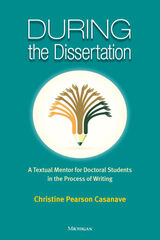 During the Dissertation: A Textual Mentor for Doctoral Students in the Process of Writing
Christine Pearson Casanave
University of Michigan Press, 2020 "A textual mentor like During the Dissertation can fill a void in writers’ lives at a time of solitude, uncertainty, and anxiety. Keep it under your pillow.”
This volume is a sequel to Casanave’s popular Before the Dissertation. Like that volume, this book is designed as a companion for doctoral dissertation writers of qualitative or mixed methods work in fields related to language education. It could also benefit those writing master’s theses and those writing in other social science fields. It is meant to be consulted once the writing has begun—once students have settled on a topic, designed the project, or collected the data—because this is the time when they are analyzing, drafting, revising, polishing, and probably fretting, deleting, reconstructing, and even losing sleep. Also, like its predecessor, it is not designed to teach anyone how to write a dissertation as there are plenty of those available elsewhere.
For most doctoral students, writing will happen at different stages of the project. Strategies for timing of these kinds of writing differ across students, and also across supervisors and advisers. If dissertation writers do not know by the time they start writing which strategies and issues pertain to them, this book can help them craft some approaches to suit their own personalities, preferred practices, and individual goals and visions, as well as help them figure out how dissertation writing might fit into the real-life intrusions of work and family.
Issues covered in the book are: starting to write, envisioning the project as a whole, relationships with supervisors, perfectionism and other maladies, health, low- and high-IQ days, loneliness and isolation, distractions and interruptions, revising, and knowing when to stop.
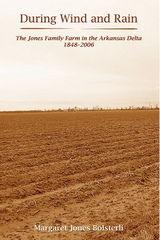 During Wind and Rain: The Jones Family Farm in the Arkansas Delta 1848-2006
Margaret Jones Bolsterli
University of Arkansas Press, 2008 n telling the story of five generations of her family and its farm in the Arkansas Delta, Margaret Jones Bolsterli brings together her own research, historical perspective, and family lore as it reaches her from the days of her great-grandfather down to her nephew. The result is a family saga that is at once universal and personal, historical and timeless. During Wind and Rain moves from the land’s acquisition in 1848 through the Civil War and Reconstruction, the 1927 Flood, the Great Depression, and the drought of 1930 to the modern considerations of mechanization, fertilizer, pesticides, and irrigation. The transformation of dense swamp and forest to today’s commercial agriculture is the story of two hundred acres worked by people sowing their fate with sweat, ingenuity, and luck. From the hoes of Bolsterli’s great-grandfather Uriah’s time to her nephew Casey’s machinery capable of cultivating an acre in five minutes, During Wind and Rain poignantly portrays five generations of farmers motivated by dreams of “a crop so good that the memory of it can warm the drafty floors of adversity for the rest of one's life.”
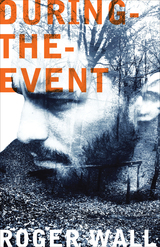 During-the-Event
Roger Wall
University of Alaska Press, 2019 For D.E., only two certainties exist: his grandfather is dead and life will never be the same.
During-the-Event is a dystopian adventure that roams across a fallen United States, introducing an unforgettable cast of characters along the way. In the near future, climate change has ravaged the United States, leading the government to overcorrect through culls and relocation. Those who survive the mandated destruction are herded into “habitable production zones,” trading their freedom for illusions of security. The few who escape learn quickly that the key to survival is to stay hidden in the corners of the country. For seventeen years, During-the-Event, or D.E., has lived free in a pastoral life with his grandfather in North Dakota. But when death reaches their outpost. D.E. is forced on a journey that will change his life—and reveal surprises about his past.
Once taught that strangers are only sources of pain, D.E. must learn to trust the people he meets on his journey. During-the-Event is a soaring coming-of-age story that grapples with achingly familiar issues: coming to terms with loss and loneliness, finding what our identities really mean, and searching for love in an often strange and bewildering world.
 Durkheim: A Critical Introduction
Kieran Allen and Brian O'Boyle
Pluto Press, 2017 Emile Durkheim, along with Karl Marx and Max Weber, is one of the three 'founding fathers of sociology'. This is the first book to situate his sociology in the context of his republican politics, freeing his ideas from more conventional studies and allowing the reader to see his ideas afresh.
This critical introduction argues that Durkheim's defence of Republican France in the 1890s had a considerable influence on his sociology, which cannot be fully understood when removed from its historical and political context. His dismissal of economic factors in suicide rates, the influence of his anti-feminist position on his findings on marriage rates, and the idealism behind his claim that religion is the key determinant in shaping society are all discussed.
Through analysing his writings, including The Division of Labour in Society, Suicide and The Elementary Forms of Religious Life, this book provides a fascinating, critical counterpoint to the existing works on this key figure of sociology.
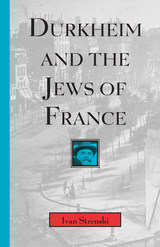 Durkheim and the Jews of France
Ivan Strenski
University of Chicago Press, 1997 Ivan Strenski debunks the common notion that there is anything "essentially" Jewish in Durkheim's work. Seeking the Durkheim inside the real world of Jews in France rather than the imagined Jewishness inside Durkheim himself, Strenski adopts a Durkheimian approach to understanding Durkheim's thought. In so doing he shows for the first time that Durkheim's sociology (especially his sociology of religion) took form in relation to the Jewish intellectual life of late nineteenth- and early twentieth-century France.
Strenski begins each chapter by weighing particular claims (some anti-Semitic, some not) for the Jewishness of Durkheim's work. In each case Strenski overturns the claim while showing that it can nonetheless open up a fruitful inquiry into the relation of Durkheim to French Jewry. For example, Strenski shows that Durkheim's celebration of ritual had no innately Jewish source but derived crucially from work on Hinduism by the Jewish Indologist Sylvain Lévi, whose influence on Durkheim and his followers has never before been acknowledged.
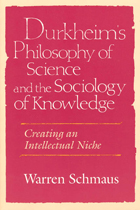 Durkheim's Philosophy of Science and the Sociology of Knowledge: Creating an Intellectual Niche
Warren Schmaus
University of Chicago Press, 1994 In this demonstration of the link between philosophy of science and scientific practice, Warren Schmaus argues that Durkheim's philosophy is crucial to his sociology. Through a reinterpretation of the relation between Durkheim's major philosophical and sociological works, Schmaus argues that Durkheim's sociology is more than a collection of general observations about society—it reflects a richly constructed theory of the meanings and causes of social life.
Schmaus shows how Durkheim sought to make sociology more rigorous by introducing scientific methods of analysis and explanation into the study of society. Durkheim tried to reveal how implicit, commonly held beliefs actually govern people's lives. Through an original interpretation of Durkheim's landmark writings, Schmaus argues that Durkheim, in his empirical studies, refined both the methods of sociology and a theory about society's shared knowledge and practices.
This book opens a new window on the development of Durkheim's thought and demonstrates how a philosophy of science can inspire the rise of a new science.
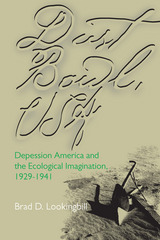 Dust Bowl, USA: Depression America and the Ecological Imagination, 1929–1941
Brad D. Lookingbill
Ohio University Press, 2001 Whether romantic or tragic, accounts of the dramatic events surrounding the North American Dust Bowl of the “dirty thirties” unearthed anxieties buried deep in America’s ecological imagination. Moreover, the images of a landscape of fear remain embedded in the national consciousness today. In vivid form, the aesthetic of suffering captured in Dorothea Lange’s photographs and Woody Guthrie’s folk songs created the myths and memories of the Depression generation. Dust Bowl, USA is a critical examination of the stories that grew out of the Dust Bowl experience. Across the nation, newspapers, magazines, books, films, and songs produced imagery of blight for local and mass audiences. As new technology, irrigation innovations, and conservation programs were introduced on a wide scale during the 1930s, the saga of the frontier continued to unfold through accounts of dust, drought, and desertification. In piercing the myths brought forth in legends, lore, allegories, and anecdotes, Brad Lookingbill provides a revelatory insight into the history of the cultural narratives that have come to define an era.
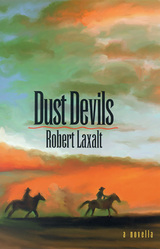 Dust Devils: A Novella
Robert Laxalt
University of Nevada Press, 1997 An action-packed story set during the violent and conflict-ridden days of the early 20th century, Dust Devils takes place in the rugged mountains and deserts of Eastern California and Northern Nevada. Ira Hamilton, the teenage son of rugged Indian-hating rancher John D. Hamilton, wins the bronc-riding competition at a local rodeo and comes away with a special prize: a beautiful Arabian colt. But the horse is soon stolen by Hawkeye, a notorious local rustler. Accompanied by Cricket, a young Paiute who has been his closest companion since infancy, Ira vows to retrieve his prize. On the way, Ira must find the courage to overcome the challenges of nature and outlaw, and to love the woman of his choice. This vivid tale will thrill readers with its authentic depiction of Nevada's lonely back country, its hardy ranchers, and its native peoples. Ira Hamilton's adventure shows us the last days of the Old West, when cowboys, sheepmen, and Indians still struggled to survive and overcome their long-standing animosities, and violent men rode boldly and unhindered across the harsh landscape.
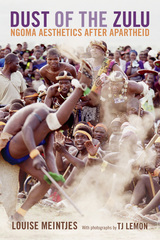 Dust of the Zulu: Ngoma Aesthetics after Apartheid
Louise Meintjes
Duke University Press, 2017 In Dust of the Zulu Louise Meintjes traces the political and aesthetic significance of ngoma, a competitive form of dance and music that emerged out of the legacies of colonialism and apartheid in South Africa. Contextualizing ngoma within South Africa's history of violence, migrant labor, the HIV epidemic, and the world music market, Meintjes follows a community ngoma team and its professional subgroup during the twenty years after apartheid's end. She intricately ties aesthetics to politics, embodiment to the voice, and masculine anger to eloquence and virtuosity, relating the visceral experience of ngoma performances as they embody the expanse of South African history. Meintjes also shows how ngoma helps build community, cultivate responsible manhood, and provide its participants with a means to reconcile South Africa's past with its postapartheid future. Dust of the Zulu includes over one hundred photographs of ngoma performances, the majority taken by award-winning photojournalist TJ Lemon.
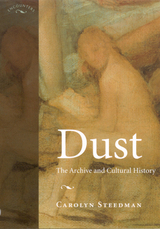 Dust: The Archive and Cultural History
Carolyn Steedman
Rutgers University Press, 2002 In this witty, engaging, and challenging book, Carolyn Steedman has produced an originaland sometimes irreverentinvestigation into how modern historiography has developed. Dust: The Archive and Cultural History considers our stubborn set of beliefs about an objective material worldinherited from the nineteenth centurywith which modern history writing and its lack of such a belief, attempts to grapple. Drawing on her own published and unpublished writing, Carolyn Steedman has produced a sustained argument about the way in which history writing belongs to the currents of thought shaping the modern world. Steedman begins by asserting that in recent years much attention has been paid to the archive by those working in the humanities and social sciences; she calls this practice "archivization." By definition, the archive is the repository of "that which will not go away," and the book goes on to suggest that, just like dust, the "matter of history" can never go away or be erased. This unique work will be welcomed by all historians who want to think about what it is they do.
 The Dust Within the Rock: A Novel
Frank Waters
Ohio University Press, 2002 Based on one of the most significant periods in Frank Waters’s own life, Pike’s Peak is perhaps the most complete expression of all the archetypal themes he explored in both fiction and nonfiction. In The Dust within the Rock, the third book in the Pike’s Peak saga, an aging Joseph Rogier clings to his vision of finding gold in the great mountain and his grandson Marsh comes of age in the Rogier household. It is the early part of the twentieth century, in Colorado Springs, and the schoolhouse, the newsstand, the railroad, the mines, all become part of the younger man’s emergence into adulthood and self-discovery. Waters’s powerful and intuitive style transforms the tale into a mythic journey, a search for meaning played out in the drama of everyday living on the vast American frontier. Pike’s Peak (1971) is composed of three condensed novels: The Wild Earth’s Nobility, Below Grass Roots, and The Dust within the Rock. Some years after its publication, an interviewer asked Frank Waters whether it was autobiographical. “Yes,” he replied, “and no.”
 The Dustbin of History
Greil Marcus
Harvard University Press, 1995 "How much history can be communicated by pressure on a guitar string?" Robert Palmer wondered in Deep Blues. Greil Marcus answers here: more than we will ever know. It is the history in the riff, in the movie or novel or photograph, in the actor's pose or critic's posturing--in short, the history in cultural happenstance--that Marcus reveals here, exposing along the way the distortions and denials that keep us oblivious if not immune to its lessons.
Whether writing about the Beat Generation or Umberto Eco, Picasso's Guernica or the massacre in Tiananmen Square, The Manchurian Candidate or John Wayne's acting, Eric Ambler's antifascist thrillers or Camille Paglia, Marcus uncovers the histories embedded in our cultural moments and acts, and shows how, through our reading of the truths our culture tells and those it twists and conceals, we situate ourselves in that history and in the world. Rarely has a history lesson been so exhilarating. With the startling insights and electric style that have made him our foremost writer on American music, Marcus brings back to life the cultural events that have defined us and our time, the social milieu in which they took place, and the individuals engaged in them. As he does so, we see that these cultural instances--as lofty as The Book of J, as humble as a TV movie about Jan and Dean, as fleeting as a few words spoken at the height of the Berkeley Free Speech Movement, as enduring as a Paleolithic painting--often have more to tell us than the master-narratives so often passed off as faultless representations of the past.
Again and again Marcus skewers the widespread assumption that history exists only in the past, that it is behind us, relegated to the dustbin. Here we see instead that history is very much with us, being made and unmade every day, and unless we recognize it our future will be as cramped and impoverished as our present sense of the past.
 Dust-Up: Asbestos Litigation and the Failure of Commonsense Policy Reform
Jeb Barnes
Georgetown University Press, 2011 In an era of polarization, narrow party majorities, and increasing use of supermajority requirements in the Senate, policy entrepreneurs must find ways to reach across the aisle and build bipartisan coalitions in Congress. One such coalition-building strategy is the “politics of efficiency,” or reform that is aimed at eliminating waste from existing policies and programs. After all, reducing inefficiency promises to reduce costs without cutting benefits, which should appeal to members of both political parties, especially given tight budgetary constraints in Washington. Dust-Up explores the most recent congressional efforts to reform asbestos litigation—a case in which the politics of efficiency played a central role and seemed likely to prevail. Yet, these efforts failed to produce a winning coalition, even though reform could have saved billions of dollars and provided quicker compensation to victims of asbestos-related diseases. Why? The answers, as Jeb Barnes deftly illustrates, defy conventional wisdom and force us to rethink the political effects of litigation and the dynamics of institutional change in our fragmented policymaking system. Set squarely at the intersection of law, politics, and public policy, Dust-Up provides the first in-depth analysis of the political obstacles to Congress in replacing a form of litigation that nearly everyone—Supreme Court justices, members of Congress, presidents, and experts—agrees is woefully inefficient and unfair to both victims and businesses. This concise and accessible case study includes a glossary of terms and study questions, making it a perfect fit for courses in law and public policy, congressional politics, and public health.
 Dusty, Deek, and Mr. Do-Right: High School Football in Illinois
Taylor Bell
University of Illinois Press, 2010 From small towns like Metamora, Aledo, and Carthage to East St. Louis and Chicago's South Side, Illinois's high school football fields have been the proving ground for such future stars as Dick Butkus, Red Grange, and Otto Graham. In Dusty, Deek, and Mr. Do-Right, longtime fan and sportswriter Taylor Bell shares the stories of the greatest players, toughest coaches, most memorable games, and fiercest rivalries in Illinois history. Drawing on dozens of personal interviews, Bell profiles memorable figures such as Tuscola's record-setting quarterback Dusty Burk, Pittsfield's brutally demanding yet devoted Coach Donald "Deek" Pollard, and Evanston's Murney "Mr. Do-Right" Lazier, who coached sternly but without prejudice in the racially charged 1960s and '70s. The book also discusses winning programs at schools such as East St. Louis, Mount Carmel, and Joliet Catholic, as well as longstanding rivalries and memorable games in the state playoff and Prep Bowl. The ultimate book for high school football fans in Illinois, Dusty, Deek, and Mr. Do-Right is infused with Bell's own love for the game and illustrated with sixty photographs of the players and coaches who made lifetime memories under the Friday night lights.
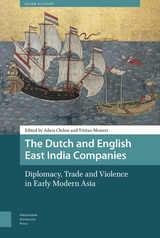 The Dutch and English East India Companies: Diplomacy, Trade and Violence in Early Modern Asia
Edited by Adam Clulow and Tristan Mostert
Amsterdam University Press, 2019 The Dutch and English East India Companies were formidable organizations that were gifted with expansive powers that allowed them to conduct diplomacy, wage war and seize territorial possessions. But they did not move into an empty arena in which they were free to deploy these powers without resistance. Early modern Asia stood at the center of the global economy and was home to powerful states and sprawling commercial networks. The companies may have been global enterprises, but they operated in a globalized region in which they encountered a range of formidable competitors. This groundbreaking collection of essays explores the place of the Dutch and English East India Companies in Asia and the nature of their engagement with Asian rulers, officials, merchants, soldiers, and brokers. With contributions from some of the most innovative historians in the field, The Dutch and English East India Companies: Diplomacy, Trade and Violence in Early Modern Asia presents new ways to understand these organizations by focusing on their diplomatic, commercial, and military interactions with Asia.
The Dutch Atlantic: Slavery, Abolition and Emancipation
Kwame Nimako and Glenn Willemsen
Pluto Press, 2011 The Dutch Atlantic interrogates the Dutch involvement in Atlantic slavery and assesses the historical consequences of this for contemporary European society.
Kwame Nimako and Glenn Willemsen show how the slave trade and slavery intertwined economic, social and cultural elements, including nation-state formation in the Netherlands and across Europe. They explore the mobilisation of European populations in the implementation of policies that facilitated Atlantic slavery and examine how European countries created and expanded laws that perpetuated colonisation.
Addressing key themes such as the incorporation of the formerly enslaved into post-slavery states and contemporary collective efforts to forget and/or remember slavery and its legacy in the Netherlands, this is an essential text for students of European history and postcolonial studies.
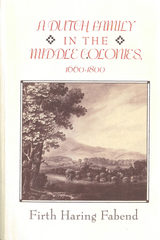 A Dutch Family in the Middle Colonies: 1660-1880
Firth Haring Fabend
Rutgers University Press, 1991 Firth Haring Fabend has studied a large colonial American family over five generations. The Haring family settled in the Hackensack Valley (on the New York/New Jersey border), where they lived, prospered, and remained throughout the eighteenth century. Fabend looks at how this ordinary family of independent, middle-class farmers coped with immigration, established themselves in a community, acquired land and capital, and took part in the social, political, economic, and religious changes of the seventeenth and eighteenth centuries. As she traces the lives of the Harings and their neighbors, Fabend focuses on their marriage and childbearing patterns, living conditions, agricultural methods, and relative economic position. She investigates inheritance patterns, concluding that the position of women deteriorated under English law. She is equally interested in the political and religious life of the family. The Harings formed a church fitting their Pietist beliefs, and this church became central to community life. Their theology encouraged them to question religious authority, which in turn fostered the questioning of political authority. Their community became a seedbed for revolutionary activity. Fabend examines the family's position in the Revolution--primarily patriot--and the losses they suffered in that conflict. The Harings of colonial America were ideal yeoman farmers, a class that stood well in the social hierarchy of the day. They were industrious, they prospered, and they participated in the civic life of colonial America. But once the new republic formed, they were not very visible. Fabend argues that they maintained their "Dutchness" more consciously than ever after the Revolution, which hindered their full participation in public affairs. In some ways, the fifth and sixth generations were more Dutch than the early generations.
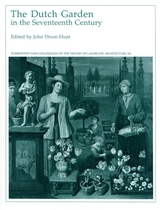 The Dutch Garden in the Seventeenth Century
John Dixon Hunt
Harvard University Press, 1990 In 1988–1989 the three hundredth anniversary of an important historical event, the ascension of William and Mary to the thrones of England and Scotland, was celebrated in the Netherlands, the United Kingdom, and the United States of America. The symposium on Dutch garden art held at Dumbarton Oaks in May 1988 was the only scholarly event during the anniversary year that focused wholly upon gardens.
This wide-ranging collection of essays charts the history, scope, and spread of Dutch garden art during the seventeenth century. A group of scholars, mostly Dutch, surveys what has been called the “golden age” of Dutch garden design. Essays discuss the political context of William’s building and gardening activities at his palace of Het Loo in the Netherlands; the development of a distinctively Dutch garden art during the seventeenth century; country house poetry; and specific estates and their gardens, such as those of Johan Maurits van Nassau-Siegen at Cleves or Sorgvliet, the estate of Hans Willem Bentinck, later the Earl of Portland. Other contributions concern typical Dutch planting and layouts, with a focus upon Jan van der Green’s much-circulated Den Nederlandtsen Hovenier; the designs of Daniel Marot, the Huguenot refugee from France, who worked for William III in both the Netherlands and England; and the attitudes of the English toward Dutch gardening as it was observed in practice and mythologized through the distorting lens of national cooperation and rivalries.
Dutch Herring: An Environmental History, c. 1600-1860
Bo Poulsen
Amsterdam University Press, 2009 In the seventeenth century, the Dutch herring fisheries in the North Sea were considered the most sophisticated and demanding fishing operation in the world. This is the first study to assess the North Sea herring and herring fisheries over the span of several centuries. It contributes to the understanding of pre-modern natural resource exploitation and the role of the natural environment in long-term development of the Dutch herring fisheries.
Dutch in Michigan
Larry Ten Harmsel
Michigan State University Press, 2002 Even though they are historically one of the smaller immigrant streams, nineteenth-century Dutch migrants and their descendants have made parts of West Michigan their own. The first Dutch in Michigan were religious dissenters whose commitment to Calvinism had long-reaching effects on their communities, even in the face of later waves of radicalized industrial immigrants and the challenges of modern life. From Calvin College to Meijer Thrifty Acres and the Tulip Festival, the Dutch presence has enriched and informed people throughout the state. Larry ten Harmsel skillfully weaves together the strands of history and modern culture to create a balanced and sensitive portrayal of this vibrant community.
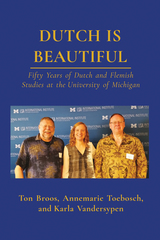 Dutch is Beautiful: Fifty Years of Dutch and Flemish Studies at the University of Michigan
Ton Broos, Annemarie Toebosch, and Karla Vandersypen
Michigan Publishing, 2019 Dutch is Beautiful tells the story of the fifty years of Dutch and Flemish Studies at the University of Michigan in Ann Arbor, Michigan, USA. It is an account of the efforts to promote Dutch and Flemish culture and language, as well as a description of how the teaching of Dutch language, literature, history and culture can be a tool to look at a world of diverse identities. It also offers a comprehensive overview of the beginnings of a successful program that included Dutch writers-in-residence, visiting Netherlands professors, cultural and educational events, arts, music, films, conferences and publications. Several alumni of the program look back at their college years with appreciation. Articles and essays on history, Anne Frank, and conversations on colonialism discuss critical and educational views on Dutch and Flemish Studies in past, present and future, when diversity, equity and inclusion are important goals and objectives, and public scholarship and academic activism will be a larger part of the curriculum. This book will inform, entertain, stimulate and impress everyone who is interested in the culture of the Low Countries. The title says it all!
Dutch Jewry in a Cultural Maelstrom: 1880-1940
Edited by Judith Frishman and Hetty Berg
Amsterdam University Press, 2008 Not only the Jews but Dutch society at large was caught up in a cultural maelstrom between 1880 and 1940. In failing to form a separate pillar in a period when various population groups were doing just that, the Jews were certainly unlike contemporary Catholics or Protestants. In fact, the Jews were not trying to gain entrance in a pre-existing culture but were involved with non-Jews in constructing a new culture. The complexity of Dutch Jewish history once again becomes evident if not new.
The Dutch National Research Agenda in perspective: A reflection on Research and Science Policy in practice
Edited by Beatrice de Graaf, Alexander Rinnooy Kan, and Henk Molenaar
Amsterdam University Press, 2017 The Dutch National Research Agenda is a set of national priorities that are set by scientists working in conjunction with corporations, civil society organisations, and interested citizens. The agenda consolidates the questions that scientific research will be focused on in the coming year. This book covers the current status of the Dutch National Research Agenda and considers what changes and adjustments may need to be made to the process in order to keep Dutch national research at the top of the pack.
Dutch Ovens Chronicled: Their Use in the United States
John G. Ragsdale
University of Arkansas Press, 2015 When a significant number of Americans had to prepare meals in the out of doors—colonists, pioneers moving west, cowboys working the range, or sheep herders—they needed something portable to cook their food in. Iron casters filled that need by turning out various pots, pans, and ovens to be carried to cabins, campfires, wagon trains, and camping trails. One such vessel was the Dutch oven, which had been in use for generations.
Dutch Ovens Chronicled offers a history of the development, care, and use of these ovens, complete with photos and recipes. This authoritative, informative, and eminently readable guide will be appreciated by outdoor enthusiasts, antiquarians, and history buffs alike.
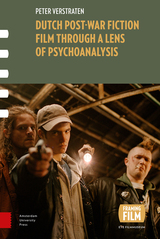 Dutch Post-war Fiction Film through a Lens of Psychoanalysis
Peter Verstraten
Amsterdam University Press, 2021 Dutch Post-war Fiction Film through a Lens of Psychoanalysis is a sequel to Humour and Irony in Dutch Post-war Fiction Film (AUP, 2016), but the two studies can be read separately. Because of the sheer variety of Fons Rademakers’ oeuvre, which spans ‘art’ cinema and cult, genre film and historical epics, each chapter will start with one of his titles to introduce a key concept from psychoanalysis. It is an oft-voiced claim that Dutch cinema strongly adheres to realism, but this idea is put into perspective by using psychoanalytic theories on desire and fantasy. In the vein of cinephilia, this study brings together canonical titles (Als twee druppels water; Soldaat van Oranje) and little gems (Monsieur Hawarden; Kracht). It juxtaposes among others Gluckauf and De vliegende Hollander (on father figures); Flanagan and Spoorloos (on rabbles and heroes); De aanslag and Leedvermaak (on historical traumas); and Antonia and Bluebird (on aphanisis).
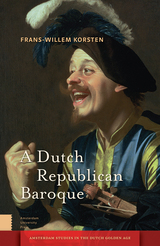 A Dutch Republican Baroque: Theatricality, Dramatization, Moment and Event
Frans-Willem Korsten
Amsterdam University Press, 2018 In the Dutch Republic, in its Baroque forms of art, two aesthetic formal modes, theatre and drama, were dynamically related to two political concepts, event and moment. The Dutch version of the Baroque is characterised by a fascination with this world regarded as one possibility out of a plurality of potential worlds. It is this fascination that explains the coincidence in the Dutch Republic, strange at first sight, of Baroque exuberance, irregularity, paradox, and vertigo with scientific rigor, regularity, mathematical logic, and rational distance. In giving a new historical perspective on the Baroque as a specifically Dutch republican one, this study also offers a new and systematic approach towards the interactions among the notions of theatricality, dramatisation, moment, and event: concepts that are currently at the centre of philosophical and political debates but the modern articulation of which can best be considered in the explorations of history and world in the Dutch Republic.
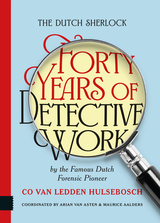 The Dutch Sherlock: Forty Years of Detective Work by the Famous Dutch Forensic Pioneer Co van Ledden Hulsebosch
Maurice Aalders
Amsterdam University Press, 2024 In the beginning of the 20th century, inspired by the Sherlock Holmes novels of Arthur Conan Doyle, scientists began to make their appearance at the crime scene. It was quickly discovered that studying the ‘silent witnesses’, crime-related physical evidence and traces, could provide a wealth of information. In many countries pioneers started to shape this new science area by formulating key principles and introducing novel methods and instrumentation. In the Netherlands, Co van Ledden Hulsebosch emerged as the first dedicated forensic scientist, and he quickly became a well-known figure. In 1945 he published his memoirs Forty Years of Detective Work, where he describes his most memorable cases and provides the reader with entertaining insights in how he was able to solve so many crimes through sound reasoning and the use of science.
Almost eighty years later, a forensic academic network in the Netherlands is celebrating its 10-year anniversary. This network, consisting of forensic scientists from Dutch universities, academic medical centers, the Dutch Police, and the Netherlands Forensic Institute, is named after this Dutch forensic legend: the Co van Ledden Hulsebosch Center (clhc). For this special occasion, clhc-affiliated scientists and experts translated the memoirs of Co van Ledden Hulsebosch with the use of modern AI tools while also providing contemporary views and insights.
Be amazed how relevant the work of Co van Ledden Hulsebosch still is for criminal investigations in the 21st century!
 Dutch Ships in Tropical Waters: The Development of the Dutch East India Company (VOC) Shipping Network in Asia 1595-1660
Robert Parthesius
Amsterdam University Press, 2010
During the closing years of the sixteenth century, the Dutch East India Company fast became a political and economic force in Asia, en route to becoming the leading private company in the world by 1660. This definitive volume explores perhaps the most important tool in the company’s trade: its ships. Robert Parthesius here reconstructs the complete shipping activities of the Company through a unique database that charts the movements of even previously ignored smaller vessels. Demonstrating that the wide range of types and sizes of vessels were indeed what gave the Company the ability to sail—and to continue its profitable trade—year after year, Dutch Ships in Tropical Waters combines the best of maritime history and archaeological research in order to change our understanding of the logistical dynamics behind one of the most important and successful businesses of this period.
The Dutch Transatlantic Slave Trade: New Methods, Perspectives, and Sources
Ramona Negrón
Amsterdam University Press, 2025 In this book, a new generation of scholars offers fresh perspectives on the history of the Dutch slave trade. Traditionally, Dutch research has focused on business practices, often overlooking the enslaved and the complexities of illegal trade and violence. By experimenting with innovative methodologies and underutilised primary sources, this volume reveals the potential to uncover perspectives of enslaved people aboard slave ships, to investigate unstudied areas like sexual violence, and to examine the roles of Dutch elite in the trade.
Duties of the Spirit
Patricia Fargnoli
Tupelo Press, 2005 Duties of the Spirit is comprised of deeply moving, lyrical and unforgettable explorations of the joys and fears that come with growing older in America.
“These poems are stamped with an energetic and outgoing attentiveness to the world. This, so much more than just the humming examination of the self, is what makes writing a sacred thing. Who does this is a true poet, and few do it better than Patricia Fargnoli.”
— Mary Oliver
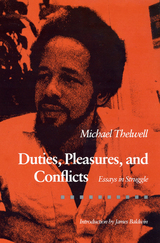 Duties, Pleasures, and Conflicts: Essays in Struggle
Michael M. Thelwell
University of Massachusetts Press, 1987 This powerful collection of essays and short stories provides a unique perspective on the black civil rights movement over the past twenty-five years. A long-time activist, Michael Thelwell was a member of the Student Non-Violent Coordinating Committee [SNCC] and the Mississippi Freedom Democratic Party in the early 1960s, a founder of the W.E.B. Du Bois Department of Afro-American Studies at the University of Massachusetts in 1970, author of the widely praised novel The Harder They Come published in 1980, and an organizer for Jesse Jackson's presidential campaign in 1984. Thelwell is a writer of rare grace, integrity, and strong political convictions.
The collection begins with three stories. Set in the Mississippi Delta in the 1960s, the stories explore how individuals manage to preserve their dignity in a world of racism and violence. The next six essays, also written in the 1960s, are historical and journalistic. They discuss the March on Washington for Jobs and Freedom, the situation in the South as seen by SNCC workers, the political challenges in Mississippi, the articulation of the Black Power movement, the causes of the black student revolt at Cornell, and the need for Black Studies as the intellectual offensive in the struggle for black liberation.
The section that follows is composed of literary pieces: two appreciative essays on James Baldwin, two critical reviews of William Styron and his treatment of Nat Turner, an excoriating assessment of V. S. Naipaul, a profile of Amos Tutuola, and a thoughtful analysis of the social responsibility of the black writer.
The final essay examines the history of Jesse Jackson's presidential campaign and comments on the political climate of the 1980s.
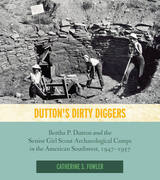 Dutton's Dirty Diggers: Bertha P. Dutton and the Senior Girl Scout Archaeological Camps in the American Southwest, 1947–1957
Catherine S. Fowler
University of Utah Press, 2020 Catherine Fowler chronicles a significant yet little-known program for Girl Scouts in post–WWII America. At a time when women were just beginning to enter fields traditionally dominated by men, these two-week camping caravans and archaeological excavations introduced teenage girls not only to the rich cultural and scientific heritage of the American Southwest but to new career possibilities. Dr. Bertha Dutton, curator at the Museum of New Mexico, served as trip leader. While on the road and in camp, Dutton and other experts in anthropology, archaeology, geology, natural history, and more helped the campers appreciate what they were seeing and learning. This book details the history of the program, sharing trip itineraries and selected memories from the nearly three hundred girls who attended the camps. It also serves as a mini-biography and tribute to Bertha Dutton, who, through her knowledge, teaching, and strong persona, provided a role model for these young women, many of whom later pursued careers in anthropology and related fields.
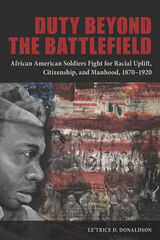 Duty beyond the Battlefield: African American Soldiers Fight for Racial Uplift, Citizenship, and Manhood, 1870–1920
Le'Trice D. Donaldson
Southern Illinois University Press, 2020 In a bold departure from previous scholarship, Le’Trice D. Donaldson locates the often overlooked era between the Civil War and the end of World War I as the beginning of black soldiers’ involvement in the long struggle for civil rights. Donaldson traces the evolution of these soldiers as they used their military service to challenge white notions of an African American second-class citizenry and forged a new identity as freedom fighters willing to demand the rights of full citizenship and manhood.
Through extensive research, Donaldson not only illuminates this evolution but also interrogates the association between masculinity and citizenship and the ways in which performing manhood through military service influenced how these men struggled for racial uplift. Following the Buffalo soldier units and two regular army infantry units from the frontier and the Mexican border to Mexico, Cuba, and the Philippines, Donaldson investigates how these locations and the wars therein provide windows into how the soldiers’ struggles influenced black life and status within the United States.
Continuing to probe the idea of what it meant to be a military race man—a man concerned with the uplift of the black race who followed the philosophy of progress—Donaldson contrasts the histories of officers Henry Flipper and Charles Young, two soldiers who saw their roles and responsibilities as black military officers very differently.
Duty beyond the Battlefield demonstrates that from the 1870s to 1920s military race men laid the foundation for the “New Negro” movement and the rise of Black Nationalism that influenced the future leaders of the twentieth century Civil Rights movement.
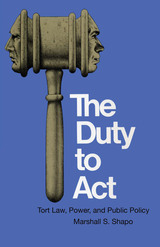 The Duty to Act: Tort Law, Power, and Public Policy
By Marshall S. Shapo
University of Texas Press, 1977 A woman terrified by the threats of a jilted suitor is denied police protection. A workman collapses on the job and the employer is slow to help him. A bully in a bar begins to carry out threats of serious injury to a customer, after the bartender’s lackadaisical response. Springing from varied areas of human activity, such cases occupy an important area of the legal battleground called modern tort law. They also provide the basis for a fascinating legal analysis by Marshall S. Shapo. Tort law is an important social mediator of events surrounding personal injuries. It impinges on many other areas of the law—those dealing with crime, constitutional protections against government officials and agencies, and property rights. Since litigated tort cases often involve brutal treatment or accidents inflicting severe physical harm, this area of the law generates much emotion and complex legal doctrine. Shapo cuts through the emotion and the complexity to present a view of these problems that is both legally sound and intuitively appealing. His emphasis is on power relationships between private citizens and other individuals, as well as between private persons and governments and officials. He undertakes to define power in a meaningful way as it relates to many tort issues faced by ordinary citizens, and to make this definition precise by constant reference to concrete cases. His particular focus is on an age-old problem in tort law: the question of when a person has a duty to aid another in peril. In analyzing a large number of cases in this category, Shapo develops an analysis that blends considerations of economic efficiency and humanitarian concern. Recognizing that economic considerations are significant in judicial analysis of these cases, he emphasizes elements that go beyond a simple concern with efficiency, especially the ability of one person to control another’s actions or exposure to risk. These considerations of power and corresponding dependence provide the basis for Shapo’s study of the duties of both private citizens and governments to prevent injury to others. Calling on a broad range of legal precedents, he also refers to social science research dealing with the behavior of bystanders when fellow citizens are under attack. Beyond his application of a power-based analysis to litigation traditionally based in tort doctrine, Shapo offers some speculative suggestions on the possible applicability of his views to several controversial areas of welfare law: medical care, municipal services, and educational standards. This book was written with a view to readership by interested citizens as well as legal scholars, judges, and practicing attorneys.
Duty to Respond: Mass Crime, Denial, and Collective Responsibility
Nenad Dimitrijevic
Central European University Press, 2011 The subject of the book is responsibility for collective crime. Collective crime is an act committed by a significant number of the members of a group, in the name of all members of that group, with the support of the majority of group members, and against individuals targeted on the basis of their belonging to a different group.The central claim is that all members of the group in whose name collective crime is committed share responsibility for it. This book's special interest is with analytical and normative defense of arguments that purport to explain reasons for, and the character of, responsibility of decent people. Those who did not intend, support, or committed wrong, are still accountable in a non-vicarious manner. The basis of their responsibility is the crime-specific relationship between group identity and personal identity.
 Duty To Warn: A Novel
Sara Kersting
Acre Books, 2018 While treating Robert Percy, a burly factory worker, psychologist David Malden unlocks not only his patient’s memories of childhood abuse but also an upwelling violence. When Percy abruptly departs Buffalo for rural Michigan, where he grew up in a series of foster homes, Malden fears that his patient seeks revenge. Concerned with his liability under Duty to Warn laws, Malden sets out after the troubled young man using the only guide he has, his treatment notes—a list of people and places that may or may not exist, especially after twenty years.
To aid him in the chase, Malden calls on his colleague, the awkward, remote, intimidatingly tall Sonja Nielsen. She reluctantly agrees to help, either because of or despite her previous entanglements with Malden.
Told from the perspectives of these three characters, the story swerves and jolts and switches back, much like Percy’s recollections of his upbringing. Kersting presents the interior struggles of her characters in a searingly spare style, all the while drawing the reader through an escalating series of events as Percy hitches rides and takes buses, searching the small towns of central Michigan, alternately helped and hindered by both old and new acquaintances.
While following disparate leads toward Percy’s final, surprising destination, all three conflicted souls are compelled to examine their loyalties, test their convictions, admit their frailties, and confront the ghosts lurking in their pasts, resulting in a revelatory climax.
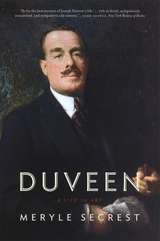 Duveen: A Life in Art
Meryle Secrest
University of Chicago Press, 2005 Anyone who has admired Gainsborough's Blue Boy of the Huntington Collection in California, or Rembrandt's Aristotle Contemplating the Bust of Homer at the Metropolitan Museum of Art in New York owes much of his or her pleasure to art dealer Joseph Duveen (1869–1939). Regarded as the most influential—or, in some circles, notorious—dealer of the twentieth century, Duveen established himself selling the European masterpieces of Titian, Botticelli, Giotto, and Vermeer to newly and lavishly wealthy American businessmen—J. P. Morgan, John D. Rockefeller, and Andrew Mellon, to name just a few. It is no exaggeration to say that Duveen was the driving force behind every important private art collection in the United States.
The first major biography of Duveen in more than fifty years and the first to make use of his enormous archive—only recently opened to the public—Meryle Secrest's Duveen traces the rapid ascent of the tirelessly enterprising dealer, from his humble beginnings running his father's business to knighthood and eventually apeerage. The eldest of eight sons of Jewish-Dutch immigrants, Duveen inherited an uncanny ability to spot a hidden treasure from his father, proprietor of a prosperous antiques business. After his father's death, Duveen moved the company into the riskier but lucrative market of paintings and quickly became one of the world's leading art dealers. The key to Duveen's success was his simple observation that while Europe had the art, America had the money; Duveen made his fortune by buying art from declining European aristocrats and selling them to the "squillionaires" in the United States.
"By far the best account of Joseph Duveen's life in a biography that is rich in detail, scrupulously researched, and sympathetically written. [Secrest's] inquiries into early-twentieth-century collecting whet our appetite for a more general history of the art market in the first half of the twentieth century."—John Brewer, New York Review of Books
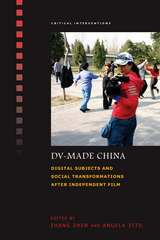 DV-Made China: Digital Subjects and Social Transformations after Independent Film
Edited by Zhang Zen and Angela Zito
University of Hawaii Press, 2015 In 1990s post-Reform China, a growing number of people armed with video cameras poured out upon the Chinese landscape to both observe and contribute to the social changes then underway. This digital turn has given us a “DV China” that includes film and media communities across different social strata and disenfranchised groups, including ethnic and religious minorities and LGBTQ communities. DV-Made China takes stock of these phenomena by surveying the social and cultural landscape of grassroots and alternative cinema practices. The volume shows how Chinese independent, amateur, and activist filmmakers energize the tension between old and new media, performance and representation, fiction and non-fiction, art and politics, China and the world. Essays by scholars in cinema and media studies, anthropology, history, Asian and Tibetan studies bring innovative interdisciplinary methodologies to critically expand upon existing scholarship on contemporary Chinese independent documentary. Their inquiries then extend to narrative feature, activist video, animation, and other digital hybrids. Portability facilitates forms of radically private film production and audience habits of small-screen consumption. Yet it also links up makers and consumers, curators and censors allowing for speedier circulation, more discussion, and quicker formations of public political and aesthetic discourses. DV-Made China introduces new frameworks in a Chinese setting that range from aesthetics to ethical activism, from digital shooting and editing techniques to the politics of film circulation in festivals and online. Politics, the authors argue, travels along paths of aesthetic excitement, and aesthetic choices, conversely, always bear ethical consequences. The films, their makers, their audiences and their distributional pathways all harbor implications for social change that are closely intertwined with the fate of media culture in a world that both contains and is influenced by China.
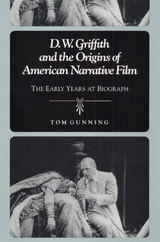 D.W. Griffith and the Origins of American Narrative Film: The Early Years at Biograph
Tom Gunning
University of Illinois Press, 1991 The legendary filmmaker D. W. Griffith directed nearly 200 films during 1908 and 1909, his first years with the Biograph Company. While those one-reel films are a testament to Griffith's inspired genius as a director, they also reflect a fundamental shift in film style from "cheap amusements" to movie storytelling complete with characters and narrative impetus. In this comprehensive historical investigation, drawing on films preserved by the Library of Congress and the Museum of Modern Art, Tom Gunning reveals that the remarkable cinematic changes between 1900 and 1915 were a response to the radical reorganization within the film industry and the evolving role of film in American society. The Motion Picture Patents Company, the newly formed Film Trust, had major economic aspirations. The newly emerging industry's quest for a middle-class audience triggered Griffith's early experiments in film editing and imagery. His unique solutions permanently shaped American narrative film.
 Dwan Gallery: Los Angeles to New York, 1959–1971
James Meyer
University of Chicago Press, 2016 Copublished with the National Gallery of Art in celebration of Virginia Dwan’s gift to the Gallery of her extraordinary personal collection, Dwan Gallery explores her remarkable career. Dwan is one of the most influential figures in the history of twentieth-century American art. Her eponymously named galleries, the first established in a Los Angeles storefront in 1959, followed by a second in New York in 1965, became a beacon for influential postwar American and European artists. She sponsored the debut show for Yves Klein in the United States, and she championed such artists as Franz Kline, Robert Rauschenberg, Claes Oldenburg, Sol LeWitt, and Ad Reinhardt. Her Los Angeles gallery featured abstract expressionism, neo-Dada, and pop, while the New York branch became associated with the emerging movements of minimalism and conceptualism. At the same time, the gallery’s influence expanded to remote locations in Nevada, Utah, and Arizona, where Dwan sponsored such iconic earthworks as Robert Smithson’s Spiral Jetty, Michael Heizer’s Double Negative, and Walter De Maria’s Lightning Field. Though Dwan was a major force in the art world of the sixties and seventies, her story and the history of her gallery have been largely unexplored—until now.
Alongside lush full-color images of one hundred leading artworks, the book deepens our understanding of the artistic exchanges Dwan facilitated during this age of mobility, when air travel and the interstate highway system linked the two coasts and transformed the making of art and the sites of its exhibition. James Meyer, the curator of the exhibition and the foremost authority on minimal art, contributes an essay that is a sophisticated and broad-ranging analysis of Dwan’s legacy.
Honoring Dwan’s significant influence and impact on postwar art, Dwan Gallery is a rich and informative collection that will be treasured by fans of contemporary art.
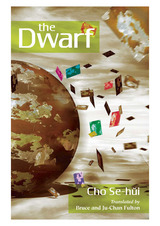 The Dwarf
Cho Se-hui and translated by Bruce and Ju-Chan Fulton
University of Hawaii Press, 2007 The dark side of South Korea’s "economic miracle" emerges in The Dwarf, Cho Se-hui’s enormously popular and critically acclaimed work. First published in 1978, it speaks to the painful social costs of reckless industrialization, even as it tellingly portrays the spiritual malaise of the newly rich and powerful and a working class subject to forces beyond its control. Cho’s lean, clipped, deceptively simple style, the rapidly shifting points of view, terse dialogue, and subtle irony evoke the particularities of life in 1970s South Korea in the presence of global economic forces.
The desperate realities of life for the dwarf, the proverbial little guy upon whose back Korea’s economic transformation largely took place, are emotively rendered in twelve linked stories examining the lives of a laboring family, a family of the newly emerging middle class, and that of a wealthy industrialist. The stories have overlapping characters and situations: the murder of a swindler, a family’s eviction from a squatter settlement, the assassination of an important executive, the dwarf ’s fantasy of a planet where life is easier, his later suicide and the subsequent fate of his dispersed friends and family members.
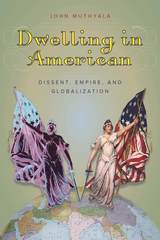 Dwelling in American: Dissent, Empire, and Globalization
John Muthyala
Dartmouth College Press, 2012 Globalization is not the Americanization of the world, argues John Muthyala. Rather, it is an uneven social, cultural, economic, and political process in which the policies and aspirations of powerful nation-states are entangled with the interests of other empires, nation-states, and communities. Dwelling in American: Dissent, Empire, and Globalization takes up a bold challenge, critiquing scholarship on American empire that views the United States as either an exceptional threat to the world or the only hope for the future. It does so in order to provincialize America, to understand it from outside the borders of nation and location, and from inside the global networks of trade, power, and culture. Using comparative frames of reference, the book makes its arguments by examining the work of a diverse range of writers including Arundhati Roy (War Talk, Power Politics), Azar Nafisi (Reading Lolita in Tehran), and Thomas Friedman (The World Is Flat). This is an original, complex, and often bracingly counterintuitive critique of the idea of American empire that will appeal to anyone interested in understanding the complexities of globalization.
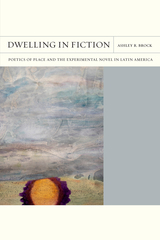 Dwelling in Fiction: Poetics of Place and the Experimental Novel in Latin America
Ashley R. Brock
Northwestern University Press, 2023 Explores the affective, ethical, and political demands that difficult reading places on readers of midcentury Latin American literature
The radical formal experiments undertaken by writers across Latin America in the mid-twentieth century introduced friction, opacity, and self-reflexivity to the very act of reading. Dwelling in Fiction: Poetics of Place and the Experimental Novel in Latin America explores the limitations and the possibilities of literature for conveying place-specific forms of life. Focusing on authors such as José María Arguedas, João Guimarães Rosa, and Juan José Saer, who are often celebrated for universalizing regional themes, Ashley R. Brock brings a new critical lens to Latin American writers who were ambivalent toward their era’s “boom.”
Beyond mere resistance to or critique of the commodification and political instrumentalization of rural topics and types, this countertrend of critical regionalism positions readers themselves as outsiders, pushing them to engage their senses, to train their attention, and to learn to dwell in unknown textual landscapes. Dwelling in Fiction draws on a transnational community of thinkers and writers to show how their midcentury aesthetic practices of sensorial pedagogy anticipate contemporary turns toward affect, embodiment, decoloniality, and ecological thought.
 Dwelling in Resistance: Living with Alternative Technologies in America
Schelly, Chelsea
Rutgers University Press, 2017 Most Americans take for granted much of what is materially involved in the daily rituals of dwelling. In Dwelling in Resistance, Chelsea Schelly examines four alternative U.S. communities—“The Farm,” “Twin Oaks,” “Dancing Rabbit,” and “Earthships”—where electricity, water, heat, waste, food, and transportation practices differ markedly from those of the vast majority of Americans.
Schelly portrays a wide range of residential living alternatives utilizing renewable, small-scale, de-centralized technologies. These technologies considerably change how individuals and communities interact with the material world, their natural environment, and one another. Using in depth interviews and compelling ethnographic observations, the book offers an insightful look at different communities’ practices and principles and their successful endeavors in sustainability and self-sufficiency.
 Dwelling on the Future: Architecture of the Seaside, Middle England and the Metropolis
Pierre d'Avoine
University College London, 2020 Dwelling on the Future studies the design of dwellings and their numerous environments. It explores how architects can, or should, respond to the complex challenges of providing humane places in which to live for a growing, multifarious population in an increasingly divided world. The issue, Pierre D’Avoine shows, is never just housing. People—individuals, groups and societies—can and do have different goals and aspirations.
D’Avoine covers a wide range of examples, including proposals for luxury housing and designs for low-cost dwellings, which all address the needs and desires of their potential inhabitants. The book explores an inclusive approach to the design of settlements—and not just in cities—that recognizes difference, an approach that demands a fresh political vision to resolve humanity’s increasing inequality, for the benefit of all. Simultaneously practical and aspirational, Dwelling on The Future casts a much needed light on our thoughts and aspirations, and on our definitions of home.
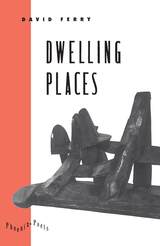 Dwelling Places: Poems and Translations
David Ferry
University of Chicago Press, 1993 Hailed as one of the best contemporary poets writing in the English language, David Ferry meditates unsentimentally, in many of these powerful and often wrenching poems, on the dispossession of people afflicted by madness, homelessness, or other forms of "wildness." The voices in all the poems in this book demonstrate how, for each of us, there is no certain dwelling place.
"David Ferry's Dwelling Places is a marvelous, extremely moving book, distinguished by Ferry's characteristic formal virtuosity, extraordinarily fresh and 'inner' translations, and a kind of driven anguished rage at both the social conditions in which human beings have to live and the mysteriously unchangeable tragedies of individual human lives. The translations amplify and deepen the contemporary scenes. I feel that in the future this will be perceived as a great book."—Frank Bidart
"Not until I had read Dwelling Places several times did I see how ingeniously resourceful, ambitious, and admirably modest a book David Ferry has made."—Boston Review
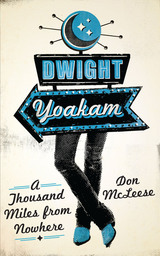 Dwight Yoakam: A Thousand Miles from Nowhere
By Don McLeese
University of Texas Press, 2012 From his formative years playing pure, hardcore honky-tonk for mid-’80s Los Angeles punk rockers through his subsequent surge to the top of the country charts, Dwight Yoakam has enjoyed a singular career. An electrifying live performer, superb writer, and virtuosic vocalist, he has successfully bridged two musical worlds that usually have little use for each other—commercial country and its alternative/Americana/roots-rocking counterpart. Defying the label “too country for rock, too rock for country,” Yoakam has triumphed while many of his peers have had to settle for cult acceptance. Four decades into his career, he has sold more than 25 million records and continues to tour regularly, with an extremely loyal fan base. In Dwight Yoakam, award-winning music journalist Don McLeese offers the first musical biography of this acclaimed artist. Tracing the seemingly disparate influences in Yoakam’s music, McLeese shows how he has combined rock and roll, rockabilly, country, blues, and gospel into a seamless whole. In particular, McLeese explores the essential issue of “authenticity” and how it applies to Yoakam, as well as to country music and popular culture in general. Drawing on wide-ranging interviews with Yoakam and his management, while also benefitting from the perspectives of others closely associated with his musical success (including producer-guitarist Pete Anderson, Yoakam’s partner throughout his most popular and creative decades), Dwight Yoakam pays tribute to the musician who has established himself as a visionary beyond time, an artist who could title an album Tomorrow’s Sounds Today and deliver it.
The Dybbuk Century: The Jewish Play That Possessed the World
Debra Caplan and Rachel Merrill Moss, Editors
University of Michigan Press, 2023 A little over 100 years ago, the first production of An-sky’s The Dybbuk, a play about the possession of a young woman by a dislocated spirit, opened in Warsaw. In the century that followed, The Dybbuk became a theatrical conduit for a wide range of discourses about Jews, belonging, and modernity. This timeless Yiddish play about spiritual possession beyond the grave would go on to exert a remarkable and unforgettable impact on modern theater, film, literature, music, and culture.
The Dybbuk Century collects essays from an interdisciplinary group of scholars who explore the play’s original Yiddish and Hebrew productions and offer critical reflections on the play’s enduring influence. The collection will appeal to scholars, students, and theater practitioners, as well as general readers.
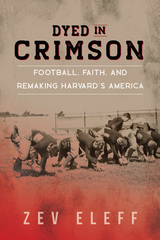 Dyed in Crimson: Football, Faith, and Remaking Harvard's America
Zev Eleff
University of Illinois Press, 2023 In 1926, Harvard athletic director Bill Bingham chose former Crimson All-American Arnold Horween as coach of the university’s moribund football team. The pair instilled a fresh culture, one based on merit rather than social status, and in the virtues of honor and courage over mere winning. Yet their success challenged entrenched ideas about who belonged at Harvard and, by extension, who deserved to lay claim to the American dream. Zev Eleff tells the story of two immigrants’ sons shaped by a vision of an America that rewarded any person of virtue. As a player, the Chicago-born Horween had led Harvard to its 1920 Rose Bowl victory. As a coach, he faced intractable opposition from powerful East Coast alumni because of his values and Midwestern, Jewish background. Eleff traces Bingham and Horween’s careers as student-athletes and their campaign to wrest control of the football program from alumni. He also looks at how Horween undermined stereotypes of Jewish masculinity and dealt with the resurgent antisemitism of the 1920s.
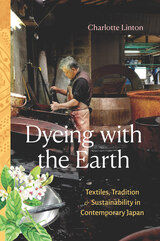 Dyeing with the Earth: Textiles, Tradition, and Sustainability in Contemporary Japan
Charlotte Linton
Duke University Press, 2025 In Dyeing with the Earth, Charlotte Linton explores the intersection of small-scale traditional craft production with contemporary sustainability practices. Focusing on natural textile dyeing on the southern Japanese island of Amami Ōshima, Linton details the complex relationship between preservation practices, resource extraction, and land access in the production of Oshima tsumugi kimono cloth, which uses the indigenous technique of dorozome (or mud-dyeing). As global interest in sustainable fashion grows, textile manufacturers on Amami have expanded from kimono production to dyeing garments and textiles for high-profile designers. While traditional craft may appear at odds with the large-scale global textile industry, Linton reveals how Amamian and global producers face similar social, economic, and environmental pressures. Ethical production in fashion, Linton contends, should focus on understanding local everyday practices that sustain direct relationships between people, place, and environment rather than rely on short-term solutions via new processes or materials. Weaving together ethnography, photography, and illustration, Linton underscores the continued relevance of traditional craft and material cultures amid ongoing climate change and biodiversity loss.
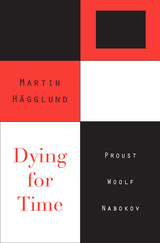 Dying for Time: Proust, Woolf, Nabokov
Martin Hägglund
Harvard University Press, 2012 Marcel Proust, Virginia Woolf, and Vladimir Nabokov transformed the art of the novel in order to convey the experience of time. Nevertheless, their works have been read as expressions of a desire to transcend time—whether through an epiphany of memory, an immanent moment of being, or a transcendent afterlife. Martin Hägglund takes on these themes but gives them another reading entirely. The fear of time and death does not stem from a desire to transcend time, he argues. On the contrary, it is generated by the investment in temporal life. From this vantage point, Hägglund offers in-depth analyses of Proust’s Recherche, Woolf’s Mrs. Dalloway, and Nabokov’s Ada.
Through his readings of literary works, Hägglund also sheds new light on topics of broad concern in the humanities, including time consciousness and memory, trauma and survival, the technology of writing and the aesthetic power of art. Finally, he develops an original theory of the relation between time and desire through an engagement with Freud and Lacan, addressing mourning and melancholia, pleasure and pain, attachment and loss. Dying for Time opens a new way of reading the dramas of desire as they are staged in both philosophy and literature.
 Dying Green: A Journey through End-of-Life Medicine in Search of Sustainable Health Care
Christine Vatovec
Rutgers University Press, 2023 The slow violence being inflicted on our environment—through everything from carbon emissions to plastic pollution—also represents an impending public health catastrophe. Yet standard health care practices are more concerned with short-term outcomes than long-term sustainability. Every resource used to deliver medical care, from IV tubes to antibiotics to electricity, has a significant environmental impact. This raises an urgent ethical dilemma: in striving to improve the health outcomes of individual patients, are we damaging human health on a global scale?
In Dying Green, award-winning educator Christine Vatovec offers an engaging study that asks us to consider the broader environmental sustainability of health care. Through a comparative analysis of the care provided to terminally ill patients in a conventional cancer ward, a palliative care unit, and an acute-care hospice facility, she shows how decisions made at a patient’s bedside govern the environmental footprint of the healthcare industry. Likewise, Dying Green offers insights on the many opportunities that exist for reducing the ecological impacts of medical practices in general, while also enhancing care for the dying in particular. By envisioning a more sustainable approach to care, this book offers a way forward that is better for both patients and the planet.
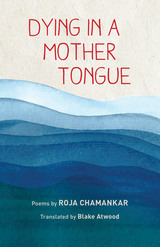 Dying in a Mother Tongue
By Roja Chamankar, Translated by Blake Atwood
University of Texas Press, 2018 This collection of poetry by the celebrated southern Iranian poet and filmmaker Roja Chamankar (b. 1981) introduces English-speaking readers to one of the most accomplished and well-loved poets of her generation. Chamankar’s work blends surrealism and the southern coastal landscape of the poet’s upbringing with everyday experiences in rapidly urbanizing Tehran. While locating herself in the modernist tradition of Iranian poets like Forugh Farrokhzad and Ahmad Shamlu through form and imagery, Chamankar infuses this tradition with concerns unique to a generation that grew up in post-revolutionary Iran and endured the effects of the Iran-Iraq war. Seascapes, love and eroticism, the disconnection of modern life, and myths and fairytales figure prominently in these vivid, lyrical poems. In the rich miniature worlds of Chamankar’s poetry, readers become privy to a range of experiences, from desire and pain to rage and humor. Sometimes abstract, other times surreal—Chamankar’s unique poetic voice, like the sea she returns to again and again, combines and sweeps these experiences to shore with assurance, strength, and beauty.
 Dying in Character: Memoirs on the End of Life
Jeffrey Berman
University of Massachusetts Press, 2012
In the past twenty years, an increasing number of authors have written memoirs focusing on the last stage of their lives: Elizabeth Kübler-Ross, for example, in The Wheel of Life, Harold Brodkey in This Wild Darkness, Edward Said in Out of Place, and Tony Judt in The Memory Chalet. In these and other end-of-life memoirs, writers not only confront their own mortality but in most cases struggle to "die in character"—that is, to affirm the values, beliefs, and goals that have characterized their lives.
Examining the works cited above, as well as memoirs by Mitch Albom, Roland Barthes, Jean-Dominique Bauby, Art Buchwald, Randy Pausch, David Rieff, Philip Roth, and Morrie Schwartz, Jeffrey Berman's analysis of this growing genre yields some surprising insights. While the authors have much to say about the loneliness and pain of dying, many also convey joy, fulfillment, and gratitude. Harold Brodkey is willing to die as long as his writings survive. Art Buchwald and Randy Pausch both use the word fun to describe their dying experiences. Dying was not fun for Morrie Schwartz and Tony Judt, but they reveal courage, satisfaction, and fearlessness during the final stage of their lives, when they are nearly paralyzed by their illnesses.
It is hard to imagine that these writers could feel so upbeat in their situations, but their memoirs are authentically affirmative. They see death coming, yet they remain stalwart and focused on their writing. Berman concludes that the contemporary end-of-life memoir can thus be understood as a new form of death ritual, "a secular example of the long tradition of ars moriendi, the art of dying."
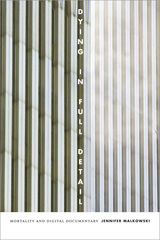 Dying in Full Detail: Mortality and Digital Documentary
Jennifer Malkowski
Duke University Press, 2017 In Dying in Full Detail Jennifer Malkowski explores digital media's impact on one of documentary film's greatest taboos: the recording of death. Despite technological advances that allow for the easy creation and distribution of death footage, digital media often fail to live up to their promise to reveal the world in greater fidelity. Malkowski analyzes a wide range of death footage, from feature films about the terminally ill (Dying, Silverlake Life, Sick), to surreptitiously recorded suicides (The Bridge), to #BlackLivesMatter YouTube videos and their precursors. Contextualizing these recordings in the long history of attempts to capture the moment of death in American culture, Malkowski shows how digital media are unable to deliver death "in full detail," as its metaphysical truth remains beyond representation. Digital technology's capacity to record death does, however, provide the opportunity to politicize individual deaths through their representation. Exploring the relationships among technology, temporality, and the ethical and aesthetic debates about capturing death on video, Malkowski illuminates the key roles documentary death has played in twenty-first-century visual culture.
 Dying Inside: The HIV/AIDS Ward at Limestone Prison
Benjamin Fleury-Steiner
University of Michigan Press, 2008 "The HIV+ men incarcerated in Limestone Prison's Dorm 16 were put there to be forgotten. Not only do Benjamin Fleury-Steiner and Carla Crowder bring these men to life, Fleury-Steiner and Crowder also insist on placing these men in the middle of critical conversations about health policy, mass incarceration, and race. Dense with firsthand accounts, Dying Inside is a nimble, far-ranging and unblinking look at the cruelty inherent in our current penal policies."
---Lisa Kung, Director, Southern Center for Human Rights "The looming prison health crisis, documented here at its extreme, is a shocking stain on American values and a clear opportunity to rethink our carceral approach to security."
---Jonathan Simon, University of California, Berkeley "Dying Inside is a riveting account of a health crisis in a hidden prison facility."
---Michael Musheno, San Francisco State University, and coauthor of Deployed "This fresh and original study should prick all of our consciences about the horrific consequences of the massive carceral state the United States has built over the last three decades."
---Marie Gottschalk, University of Pennsylvania, and author of The Prison and the Gallows "An important, bold, and humanitarian book."
---Alison Liebling, University of Cambridge "Fleury-Steiner makes a compelling case that inmate health care in America's prisons and jails has reached the point of catastrophe."
---Sharon Dolovich, University of California, Los Angeles "Fleury-Steiner's persuasive argument not only exposes the sins of commission and omission on prison cellblocks, but also does an excellent job of showing how these problems are the natural result of our nation's shortsighted and punitive criminal justice policy."
---Allen Hornblum, Temple University, and author of Sentenced to Science Dying Inside brings the reader face-to-face with the nightmarish conditions inside Limestone Prison's Dorm 16---the segregated HIV ward. Here, patients chained to beds share their space with insects and vermin in the filthy, drafty rooms, and contagious diseases spread like wildfire through a population with untreated---or poorly managed at best---HIV. While Dorm 16 is a particularly horrific human rights tragedy, it is also a symptom of a disease afflicting the entire U.S. prison system. In recent decades, prison populations have exploded as Americans made mass incarceration the solution to crime, drugs, and other social problems even as privatization of prison services, especially health care, resulted in an overcrowded, underfunded system in which the most marginalized members of our society slowly wither from what the author calls "lethal abandonment." This eye-opening account of one prison's failed health-care standards is a wake-up call, asking us to examine how we treat our forgotten citizens and compelling us to rethink the American prison system in this increasingly punitive age.
 Dying Inside: The HIV/AIDS Ward at Limestone Prison
Benjamin Fleury-Steiner
University of Michigan Press, 2009 "The HIV+ men incarcerated in Limestone Prison's Dorm 16 were put there to be forgotten. Not only do Benjamin Fleury-Steiner and Carla Crowder bring these men to life, Fleury-Steiner and Crowder also insist on placing these men in the middle of critical conversations about health policy, mass incarceration, and race. Dense with firsthand accounts, Dying Inside is a nimble, far-ranging and unblinking look at the cruelty inherent in our current penal policies."
---Lisa Kung, Director, Southern Center for Human Rights "The looming prison health crisis, documented here at its extreme, is a shocking stain on American values and a clear opportunity to rethink our carceral approach to security."
---Jonathan Simon, University of California, Berkeley "Dying Inside is a riveting account of a health crisis in a hidden prison facility."
---Michael Musheno, San Francisco State University, and coauthor of Deployed "This fresh and original study should prick all of our consciences about the horrific consequences of the massive carceral state the United States has built over the last three decades."
---Marie Gottschalk, University of Pennsylvania, and author of The Prison and the Gallows "An important, bold, and humanitarian book."
---Alison Liebling, University of Cambridge "Fleury-Steiner makes a compelling case that inmate health care in America's prisons and jails has reached the point of catastrophe."
---Sharon Dolovich, University of California, Los Angeles "Fleury-Steiner's persuasive argument not only exposes the sins of commission and omission on prison cellblocks, but also does an excellent job of showing how these problems are the natural result of our nation's shortsighted and punitive criminal justice policy."
---Allen Hornblum, Temple University, and author of Sentenced to Science Dying Inside brings the reader face-to-face with the nightmarish conditions inside Limestone Prison's Dorm 16---the segregated HIV ward. Here, patients chained to beds share their space with insects and vermin in the filthy, drafty rooms, and contagious diseases spread like wildfire through a population with untreated---or poorly managed at best---HIV. While Dorm 16 is a particularly horrific human rights tragedy, it is also a symptom of a disease afflicting the entire U.S. prison system. In recent decades, prison populations have exploded as Americans made mass incarceration the solution to crime, drugs, and other social problems even as privatization of prison services, especially health care, resulted in an overcrowded, underfunded system in which the most marginalized members of our society slowly wither from what the author calls "lethal abandonment." This eye-opening account of one prison's failed health-care standards is a wake-up call, asking us to examine how we treat our forgotten citizens and compelling us to rethink the American prison system in this increasingly punitive age.
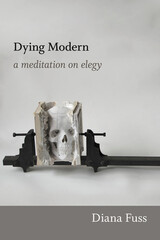 Dying Modern: A Meditation on Elegy
Diana Fuss
Duke University Press, 2013 In Dying Modern, one of our foremost literary critics inspires new ways to read, write, and talk about poetry. Diana Fuss does so by identifying three distinct but largely unrecognized voices within the well-studied genre of the elegy: the dying voice, the reviving voice, and the surviving voice. Through her deft readings of modern poetry, Fuss unveils the dramatic within the elegiac: the dying diva who relishes a great deathbed scene, the speaking corpse who fancies a good haunting, and the departing lover who delights in a dramatic exit. Focusing primarily on American and British poetry written during the past two centuries, Fuss maintains that poetry can still offer genuine ethical compensation, even for the deep wounds and shocking banalities of modern death. As dying, loss, and grief become ever more thoroughly obscured from public view, the dead start chattering away in verse. Through bold, original interpretations of little-known works, as well as canonical poems by writers such as Emily Dickinson, Randall Jarrell, Elizabeth Bishop, Richard Wright, and Sylvia Plath, Fuss explores modern poetry's fascination with pre- and postmortem speech, pondering the literary desire to make death speak in the face of its cultural silencing.
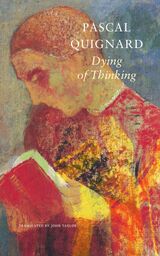 Dying of Thinking: The Last Kingdom IX
Pascal Quignard
Seagull Books, 2023 A deeply contemplative work devoted to thinking from one of the foremost literary figures of contemporary France.
Dying of Thinking is the ninth volume of Pascal Quignard’s Last Kingdom series. It explores three themes: how thought and death coincide, how thought is close to melancholy, and how thought takes shelter near traumatism. One who thinks, Quignard shows us, “compensates” for a very ancient abandonment. Even as a dream is a meaning whose disorderly, condensed, paradoxical images intuit something which has preceded sleep and which returns in them, thought is a meaning which uses words that are written, re-transcribed, dissected, etymologized and neologized. Throughout the Last Kingdom series, Quignard has sought to experience another way of thinking, one that has nothing to do with philosophy, a way of attaching himself “literally” to texts and of progressing by decomposing the imagery of dreams. Dying of Thinking is the heart of this quest.
The Dying Patient
Orville G., Jr. Brim
Russell Sage Foundation, 1970 There has hitherto been limited systematic social research on the prolongation and termination of life, and minimal agreement of the resolution of the moral and social dilemmas that dying provokes. Among the topics discussed by the contributors are: the social context of dying—when, where, and why people die; what they think about death; the cultural background of the patients' attitudes; and how medical practitioners cope with terminal illness. The social, ethical, legal, and economic problems arising from the prolongation and termination of life are also set forth.
 Dying Planet: Mars in Science and the Imagination
Robert Markley
Duke University Press, 2005 For more than a century, Mars has been at the center of debates about humanity’s place in the cosmos. Focusing on perceptions of the red planet in scientific works and science fiction, Dying Planet analyzes the ways Mars has served as a screen onto which humankind has projected both its hopes for the future and its fears of ecological devastation on Earth. Robert Markley draws on planetary astronomy, the history and cultural study of science, science fiction, literary and cultural criticism, ecology, and astrobiology to offer a cross-disciplinary investigation of the cultural and scientific dynamics that have kept Mars on front pages since the 1800s. Markley interweaves chapters on science and science fiction, enabling him to illuminate each arena and to explore the ways their concerns overlap and influence one another. He tracks all the major scientific developments, from observations through primitive telescopes in the seventeenth century to data returned by the rovers that landed on Mars in 2004. Markley describes how major science fiction writers—H. G. Wells, Kim Stanley Robinson, Philip K. Dick, Edgar Rice Burroughs, Ray Bradbury, Robert Heinlein, and Judith Merril—responded to new theories and new controversies. He also considers representations of Mars in film, on the radio, and in the popular press. In its comprehensive study of both science and science fiction, Dying Planet reveals how changing conceptions of Mars have had crucial consequences for understanding ecology on Earth.
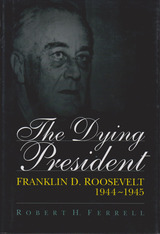 The Dying President: Franklin D. Roosevelt, 1944-1945
Robert H. Ferrell
University of Missouri Press, 1998 In this authoritative account, Robert H. Ferrell shows how the treatment of President Franklin D. Roosevelt's illness in 1944- 1945 was managed by none other than the president himself. Although this powerful American president knew that he suffered from cardiovascular disease, he went to great lengths to hide that fact—both from his physician and from the public. Why Roosevelt disguised the nature of his illness may be impossible to discern fully. He was a secretive man who liked to assign only parts of tasks to his assistants so that he, the president, would be the only one who knew the whole story. The presidency was his life, and he did not wish to give it up. The president's duplicity, though not easily measurable, had a critical effect on his performance. Placed on a four-hour-a-day schedule by his physicians, Roosevelt could apply very little time to his presidential duties. He took long vacations in South Carolina, Warm Springs, the Catoctin Mountains, and Hyde Park, as well as lengthy journeys to Hawaii, Canada, and Yalta. Important decisions were delayed or poorly made. America's policy toward Germany was temporarily abandoned in favor of the so-called Morgenthau Plan, which proposed the "pastoralization" of Germany, turning the industrial heart of Europe into farmland. Roosevelt nearly ruined the choice of Senator Harry S. Truman as his running mate in 1944 by wavering in the days prior to the party's national convention. He negotiated an agreement with Winston Churchill on sharing postwar development of nuclear weapons but failed to let the State Department know. And, in perhaps the most profoundly unwise decision, Roosevelt accepted a fourth term when he could not possibly survive it. In his final year, a year in which he faced crucial responsibility regarding World War II and American foreign policy, Franklin D. Roosevelt failed to serve the nation as a healthy president would have. Reading like a mystery story, The Dying President clears up many of the myths and misunderstandings that have surrounded Roosevelt's last year, finally revealing the truth about this missing chapter in FDR's life.
The Dying Sahara: US Imperialism and Terror in Africa
Jeremy Keenan
Pluto Press, 2013 In The Dark Sahara (Pluto, 2009), Jeremy Keenan exposed the collusion between the US and Algeria in fabricating terrorism to justify a new ‘Saharan front’ in Washington’s War on Terror. Now, in The Dying Sahara, he reveals how the designation of the region as a ‘Terror Zone’ has destroyed the lives and livelihoods of thousands of innocent people.
Beginning in 2004, with what local people called the US ‘invasion’ of the Sahel, The Dying Sahara shows how repressive, authoritarian regimes - cashing in on US terrorism ‘rents’ - provoked Tuareg rebellions in both Niger and Mali. Further, he argues that US activity has unleashed a new, narco-trafficking branch of Al-Qaeda.
Keenan's chillingly detailed research shows that the US and its new combatant African command (AFRICOM) have created instability in a region the size of western Europe.
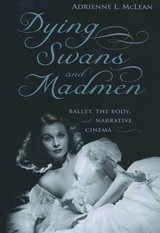 Dying Swans and Madmen: Ballet, the Body, and Narrative Cinema
McLean, Adrienne L
Rutgers University Press, 2008 From mid-twentieth-century films such as Grand Hotel, Waterloo Bridge, and The Red Shoes to recent box-office hits including Billy Elliot, Save the Last Dance, and The Company, ballet has found its way, time and again, onto the silver screen and into the hearts of many otherwise unlikely audiences. In Dying Swans and Madmen, Adrienne L. McLean explores the curious pairing of classical and contemporary, art and entertainment, high culture and popular culture to reveal the ambivalent place that this art form occupies in American life.
Drawing on examples that range from musicals to tragic melodramas, she shows how commercial films have produced an image of ballet and its artists that is associated both with joy, fulfillment, fame, and power and with sexual and mental perversity, melancholy, and death. Although ballet is still received by many with a lack of interest or outright suspicion, McLean argues that these attitudes as well as ballet's popularity and its acceptability as a way of life and a profession have often depended on what audiences first learned about it from the movies.
 Dying to Count: Post-Abortion Care and Global Reproductive Health Politics in Senegal
Siri Suh
Rutgers University Press, 2021 During the early 1990s, global health experts developed a new model of emergency obstetric care: post-abortion care or PAC. In developing countries with restrictive abortion laws and where NGOs relied on US family planning aid, PAC offered an apolitical approach to addressing the consequences of unsafe abortion. In Dying to Count, Siri Suh traces how national and global population politics collide in Senegal as health workers, health officials, and NGO workers strive to demonstrate PAC’s effectiveness in the absence of rigorous statistical evidence that the intervention reduces maternal mortality. Suh argues that pragmatically assembled PAC data convey commitments to maternal mortality reduction goals while obscuring the frequency of unsafe abortion and the inadequate care women with complications are likely to receive if they manage to reach a hospital. At a moment when African women face the highest risk worldwide of death from complications related to pregnancy, birth, or abortion, Suh’s ethnography of PAC in Senegal makes a critical contribution to studies of global health, population and development, African studies, and reproductive justice.
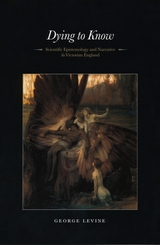 Dying to Know: Scientific Epistemology and Narrative in Victorian England
George Levine
University of Chicago Press, 2002 "Dying to Know is the work of a distinguished scholar, at the peak of his powers, who is intimately familiar with his materials, and whose knowledge of Victorian fiction and scientific thought is remarkable. This elegant and evocative look at the move toward objectivity first pioneered by Descartes sheds new light on some old and still perplexing problems in modern science." Bernard Lightman, York University, Canada
In Dying to Know, eminent critic George Levine makes a landmark contribution to the history and theory of scientific knowledge. This long-awaited book explores the paradoxes of our modern ideal of objectivity, in particular its emphasis on the impersonality and disinterestedness of truth. How, asks Levine, did this idea of selfless knowledge come to be established and moralized in the nineteenth century?
Levine shows that for nineteenth-century scientists, novelists, poets, and philosophers, access to the truth depended on conditions of such profound self-abnegation that pursuit of it might be taken as tantamount to the pursuit of death. The Victorians, he argues, were dying to know in the sense that they could imagine achieving pure knowledge only in a condition where the body ceases to make its claims: to achieve enlightenment, virtue, and salvation, one must die.
Dying to Know is ultimately a study of this moral ideal of epistemology. But it is also something much more: a spirited defense of the difficult pursuit of objectivity, the ethical significance of sacrifice, and the importance of finding a shareable form of knowledge.
 Dying Unneeded: The Cultural Context of the Russian Mortality Crisis
Michelle A. Parsons
Vanderbilt University Press, 2014 In the early 1990s, Russia experienced one of the most extreme increases in mortality in modern history. Men's life expectancy dropped by six years; women's life expectancy dropped by three. Middle-aged men living in Moscow were particularly at risk of dying early deaths. While the early 1990s represent the apex of mortality, the crisis continues. Drawing on fieldwork in the capital city during 2006 and 2007, this account brings ethnography to bear on a topic that has until recently been the province of epidemiology and demography.
Middle-aged Muscovites talk about being unneeded (ne nuzhny), or having little to give others. Considering this concept of "being unneeded" reveals how political economic transformation undermined the logic of social relations whereby individuals used their position within the Soviet state to give things to other people. Being unneeded is also gendered--while women are still needed by their families, men are often unneeded by state or family. Western literature on the mortality crisis focuses on a lack of social capital, often assuming that what individuals receive is most important, but being needed is more about what individuals give. Social connections--and their influence on health--are culturally specific.
In Soviet times, needed people helped friends and acquaintances push against the limits of the state, crafting a sense of space and freedom. When the state collapsed, this sense of bounded freedom was compromised, and another freedom became deadly.
This book is a recipient of the annual Norman L. and Roselea J. Goldberg Prize for the best project in the area of medicine.
Dylan Thomas’ Early Prose: A Study in Creative Mythology
Annis Pratt
University of Pittsburgh Press, 1970
This first full-scale treatment of the early prose of Dylan Thomas demonstrates the unity of his total work. Pratt argues that the inward journey of the poetic imagination which is implicit in poetry is often explicit in prose. Her study of Thomas’ early prose alongside his early poetry helps to elucidate all of his writing.
Pratt includes three appendices: a chronology, a summary of the critics’ attitudes toward the problem of influence, and a bibliographical sketch of materials in the Parris surrealist magazine transition, which are paralleled in Thomas’ prose.
Dynamic Ad Hoc Networks
Habib F. Rashvand
The Institution of Engineering and Technology, 2013 Motivated by the exciting new application paradigm of using amalgamated technologies of the Internet and wireless, the next generation communication networks (also called 'ubiquitous', 'complex' and 'unstructured' networking) are changing the way we develop and apply our future systems and services at home and on local, national and global scales. Whatever the interconnection - a WiMAX enabled networked mobile vehicle, MEMS or nanotechnology enabled distributed sensor systems, Vehicular Ad hoc Networking (VANET) or Mobile Ad hoc Networking (MANET) - all can be classified under new networking structures which can be given the generic title of 'ad hoc' communication networking.
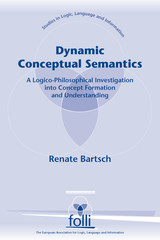 Dynamic Conceptual Semantics: A Logico-Philosophical Investigation into Concept Formation and Understanding
Renate Bartsch
CSLI, 1998 Presented in this book is a theory of concept formation and understanding that does not make use of a notion of an innate mental language as a means of concept representation. Instead, experimental concepts are treated semantically as stabilising structuring of growing sets of data, which are sets of experienced satisfaction situations for expressions, and theoretical concepts are based on coherent sets of general sentences held true. There are two kinds of structures to be established: general concepts by means of similarity sets under perspectives and historical concepts. This gives rise to a theory of understanding new situations and expressions by integrating new data into established sets of data salva stability, or by extending the conceptual structure in a metaphorical or metonymical way. The theory provides a way to understand what identity between propositional attitudes amounts to, especially how people can have more or less the same belief.
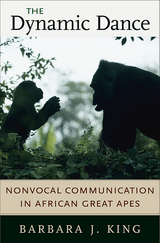 The Dynamic Dance: Nonvocal Communication in African Great Apes
Barbara J. King
Harvard University Press, 2004 Mother and infant negotiate over food; two high-status males jockey for power; female kin band together to get their way. It happens among humans and it happens among our closest living relatives in the animal kingdom, the great apes of Africa. In this eye-opening book, we see precisely how such events unfold in chimpanzees, bonobos, and gorillas: through a spontaneous, mutually choreographed dance of actions, gestures, and vocalizations in which social partners create meaning and come to understand each other.
Using dynamic systems theory, an approach employed to study human communication, Barbara King is able to demonstrate the genuine complexity of apes' social communication, and the extent to which their interactions generate meaning. As King describes, apes create meaning primarily through their body movements--and go well beyond conveying messages about food, mating, or predators. Readers come to know the captive apes she has observed, and others across Africa as well, and to understand "the process of creating social meaning."
This new perspective not only acquaints us with our closest living relatives, but informs us about a possible pathway for the evolution of language in our own species. King's theory challenges the popular idea that human language is instinctive, with rules and abilities hardwired into our brains. Rather, The Dynamic Dance suggests, language has its roots in the gestural "building up of meaning" that was present in the ancestor we shared with the great apes, and that we continue to practice to this day.
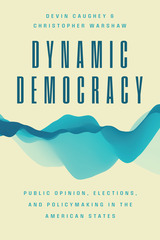 Dynamic Democracy: Public Opinion, Elections, and Policymaking in the American States
Devin Caughey and Christopher Warshaw
University of Chicago Press, 2022 A new perspective on policy responsiveness in American government.
Scholars of American politics have long been skeptical of ordinary citizens’ capacity to influence, let alone control, their governments. Drawing on over eight decades of state-level evidence on public opinion, elections, and policymaking, Devin Caughey and Christopher Warshaw pose a powerful challenge to this pessimistic view. Their research reveals that although American democracy cannot be taken for granted, state policymaking is far more responsive to citizens’ demands than skeptics claim.
Although governments respond sluggishly in the short term, over the long term, electoral incentives induce state parties and politicians—and ultimately policymaking—to adapt to voters’ preferences. The authors take an empirical and theoretical approach that allows them to assess democracy as a dynamic process. Their evidence across states and over time gives them new leverage to assess relevant outcomes and trends, including the evolution of mass partisanship, mass ideology, and the relationship between partisanship and ideology since the mid-twentieth century; the nationalization of state-level politics; the mechanisms through which voters hold incumbents accountable; the performance of moderate candidates relative to extreme candidates; and the quality of state-level democracy today relative to state-level democracy in other periods.
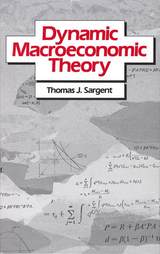 Dynamic Macroeconomic Theory
Thomas J. Sargent
Harvard University Press, 1987 The tasks of macroeconomics are to interpret observations on economic aggregates in terms of the motivations and constraints of economic agents and to predict the consequences of alternative hypothetical ways of administering government economic policy. General equilibrium models form a convenient context for analyzing such alternative government policies. In the past ten years, the strengths of general equilibrium models and the corresponding deficiencies of Keynesian and monetarist models of the 1960s have induced macroeconomists to begin applying general equilibrium models.
This book describes some general equilibrium models that are dynamic, that have been built to help interpret time-series of observations of economic aggregates and to predict the consequences of alternative government interventions. The first part of the book describes dynamic programming, search theory, and real dynamic capital pricing models. Among the applications are stochastic optimal growth models, matching models, arbitrage pricing theories, and theories of interest rates, stock prices, and options. The remaining parts of the book are devoted to issues in monetary theory; currency-in-utility-function models, cash-in-advance models, Townsend turnpike models, and overlapping generations models are all used to study a set of common issues. By putting these models to work on concrete problems in exercises offered throughout the text, Thomas Sargent provides insights into the strengths and weaknesses of these models of money. An appendix on functional analysis shows the unity that underlies the mathematics used in disparate areas of rational expectations economics.
This book on dynamic equilibrium macroeconomics is suitable for graduate-level courses; a companion book, Exercises in Dynamic Macroeconomic Theory, provides answers to the exercises and is also available from Harvard University Press.
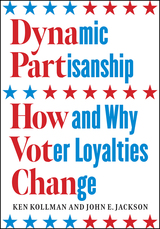 Dynamic Partisanship: How and Why Voter Loyalties Change
Ken Kollman and John E. Jackson
University of Chicago Press, 2021 Why do people identify with political parties? How stable are those identifications? Stable party systems, with a limited number of parties and mostly stable voter identification with a party, are normally considered significant signals of a steady democracy. In Dynamic Partisanship, Ken Kollman and John E. Jackson study changing patterns of partisanship in the United States, the United Kingdom, Canada, and Australia over the last fifty years in order to disentangle possible reasons for shifting partisanship and party identification. The authors argue that changes in partisanship can be explained by adjustments in voters’ attitudes toward issues or parties; the success or failure of policies advocated by parties; or alterations in parties’ positions on key issues. They contend that, while all three factors contribute, it is the latter, a party changing positions on a chief concern, that most consistently leads voters to or from a particular party. Their approach provides a deeper knowledge of the critical moving parts in democratic politics.
Dynamic Repetition: History and Messianism in Modern Jewish Thought
Gilad Sharvit
Brandeis University Press, 2022 A fine example of the best scholarship that lies at the intersection of philosophy, religion, and history.
Dynamic Repetition proposes a new understanding of modern Jewish theories of messianism across the disciplines of history, theology, and philosophy. The book explores how ideals of repetition, return, and the cyclical occasioned a new messianic impulse across an important swath of late nineteenth- and early twentieth-century German Jewish thought. To grasp the complexities of Jewish messianism in modernity, the book focuses on diverse notions of “dynamic repetition” in the works of Franz Rosenzweig, Walter Benjamin, Franz Kafka, and Sigmund Freud, and their interrelations with basic trajectories of twentieth-century philosophy and critical thought.
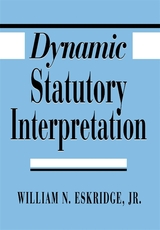 Dynamic Statutory Interpretation
William N. Eskridge, Jr.
Harvard University Press, 1994 Contrary to traditional theories of statutory interpretation, which ground statutes in the original legislative text or intent, legal scholar William Eskridge argues that statutory interpretation changes in response to new political alignments, new interpreters, and new ideologies. It does so, first of all, because it involves richer authoritative texts than does either common law or constitutional interpretation: statutes are often complex and have a detailed legislative history. Second, Congress can, and often does, rewrite statutes when it disagrees with their interpretations; and agencies and courts attend to current as well as historical congressional preferences when they interpret statutes. Third, since statutory interpretation is as much agency-centered as judge-centered and since agency executives see their creativity as more legitimate than judges see theirs, statutory interpretation in the modern regulatory state is particularly dynamic.
Eskridge also considers how different normative theories of jurisprudence—liberal, legal process, and antiliberal—inform debates about statutory interpretation. He explores what theory of statutory interpretation—if any—is required by the rule of law or by democratic theory. Finally, he provides an analytical and jurisprudential history of important debates on statutory interpretation.
 Dynamic Structure of Reality
Xavier Zubiri
University of Illinois Press, 2003 Dynamic Structure of Reality makes available in English some of the most mature thought of the modern Spanish philosopher Xavier Zubiri. He first presented this material as a set of 1968 public lectures in Madrid. They were collected, edited, and published in 1989 as Estructura dinámica de la realidad.
In 1962 Zubiri had published Sobre la esencia (On essence), a work of metaphysics that was praised by critics with one qualification: its treatment of reality was too static. The 1968 course was devised as a response to those critics. Dynamic Structure of Reality retraces the road Hegel traveled concerning the creation of a self and how that self is realized by an interplay between spirit and nature.
Like his great predecessor José Ortega y Gasset, and like his great Jewish contemporary Emmanuel Levinas, Zubiri takes religion in all seriousness and locates its questions within the questions of modern philosophy. In harmony with science, he advances a new idea of becoming. Reality, not being, becomes. As reality’s traits are revealed, in different degrees, reality resembles God, the universal self-giver. Zubiri systematically touches on many disciplines to show the varieties of self-giving--throughout the universe--of structural dynamism.
Dynamic Transcendentals: Truth, Goodness, and Beauty from a Thomistic Perspective
Alice M. Ramos
Catholic University of America Press, 2012 Addressing contemporary interest in the relationship between metaphysics and ethics, as well as the significance of beauty for ethics, Alice Ramos presents an accessible study of the transcendentals and provides a dynamic rather than static view of truth, goodness, and beauty.
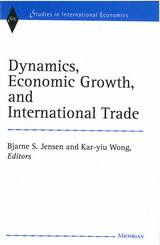 Dynamics, Economic Growth, and International Trade
Bjarne S. Jensen and Kar-yiu Wong, Editors
University of Michigan Press, 1997 While endogenous growth theory has claimed success in modeling various factors of growth and providing an analysis of sustainable economic growth, most of the growth models in published work are for closed economies. The omission of international trade, which is often regarded as the engine of growth, greatly reduces their usefulness. The theory of international trade, on the other hand, is characterized by models that are mainly static. While interest in the dynamics of trade has been growing, there is still little work in this area. The success of the newly industrialized economies that have adopted trade-oriented policies suggests how limited present trade theory is in explaining and analyzing the growth of these economies.
The work collected here serves to bridge the "old" growth theory and "new" growth theory; merge growth and trade theory; suggest new analysis and techniques of economic growth; and provide analysis of new issues related to growth and trade. The first chapter surveys endogenous growth and international trade and critically reviews the endogenous growth theory with a unified framework, covering the work on both closed and open economies. Three chapters examine the dynamics of some basic trade models; two chapters focus on growth and trade with endogenous accumulation of human and public capital; two chapters on economic growth, technological progress, and international trade; and two chapters on growth and international factor movements.
Contributors include Eric W. Bond, Theo S. Eicher, Rolf Färe, Oded Galor, Shawna Grosskopf, Bjarne S. Jensen, Pantelis Kalaitzidakis, Shoukang Lin, Ngo Van Long, Kazuo Nishimura, Koji Shimomura, Kathleen Trask, Stephen J. Turnovsky, Pham Hoang Van, Henry Wan, Jr., Chunyan Wang, and Kar-yiu Wong.
Bjarne S. Jensen is Associate Professor of Economics, Copenhagen Business School. Kar-yiu Wong is Professor of Economics, University of Washington, Seattle.
 Dynamics, Geometry, Number Theory: The Impact of Margulis on Modern Mathematics
Edited by David Fisher, Dmitry Kleinbock, and Gregory Soifer
University of Chicago Press, 2022 This definitive synthesis of mathematician Gregory Margulis’s research brings together leading experts to cover the breadth and diversity of disciplines Margulis’s work touches upon.
This edited collection highlights the foundations and evolution of research by widely influential Fields Medalist Gregory Margulis. Margulis is unusual in the degree to which his solutions to particular problems have opened new vistas of mathematics; his ideas were central, for example, to developments that led to the recent Fields Medals of Elon Lindenstrauss and Maryam Mirzhakhani. Dynamics, Geometry, Number Theory introduces these areas, their development, their use in current research, and the connections between them. Divided into four broad sections—“Arithmeticity, Superrigidity, Normal Subgroups”; “Discrete Subgroups”; “Expanders, Representations, Spectral Theory”; and “Homogeneous Dynamics”—the chapters have all been written by the foremost experts on each topic with a view to making them accessible both to graduate students and to experts in other parts of mathematics. This was no simple feat: Margulis’s work stands out in part because of its depth, but also because it brings together ideas from different areas of mathematics. Few can be experts in all of these fields, and this diversity of ideas can make it challenging to enter Margulis’s area of research. Dynamics, Geometry, Number Theory provides one remedy to that challenge.
 Dynamics of an Authoritarian System: Hungary, 2010–2021
Mária Csanádi
Central European University Press, 2022 This conceptually synthetic and empirically rich book demonstrates the vulnerability of democratic settings to authoritarianism and populism. Six scholars from various professional fields explore here the metamorphosis of a political party into a centralized authoritarian system. Viktor Orbán and his Fidesz party needed less than ten years to accomplish this transformation in Hungary. In 2010, after winning a majority that could make changes in the constitution – two-thirds of the parliamentary seats, they evolved and stabilized the system, which produced again the two-thirds majority in 2014 and 2018. The authors reveal how a democratic setting can be used as a device for political capture. They show how a political entity managed to penetrate almost all sub-fields of the economy to arrive at institutionalized corruption, and how the centralized power structure reproduces itself. With the help of a powerful empirical apparatus—among others analyses of more than 220,000 public tenders, redistributions of state subsidies, and the interconnectedness of those privileged with the political elite — the authors detail the functioning of a crony system and the network aspects of political connections in the rapid enrichment of politically-linked businesses. Their studies demonstrate the role of political capture in this redistribution and how this capture leads to a new social stratification.
The Dynamics of Business-Government Relations: Industry and Exports, 1893-1921
William H. Becker
University of Chicago Press, 1982 This work represents an important advance in the study of the interrelationships between business and U.S. foreign policy. Focusing on a single aspect of this broad field—the growth of industrial exports—William H. Becker demonstrates the complexity of business interests and behavior, of the bureaucratic and political forces at work in Congress and the Departments of Commerce and State, and of the interplay between business and governmental practices and concerns. In so doing, he provides the first full analysis of the industrial, political, and bureaucratic context in which the U.S. became a major exporter of industrial products.
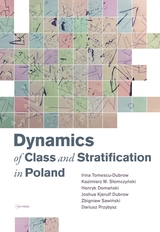 Dynamics of Class and Stratification in Poland: 1945–2015
Irina Tomescu-Dubrow
Central European University Press, 2018 This book is about long-term changes to class and inequality in Poland. Drawing upon major social surveys, the team of authors from the Polish Academy of Sciences offer the rare comprehensive study of important changes to the social structure from the communist era to the present. The core argument is that, even during extreme societal transformations, key features of social life have long-lasting, stratifying effects. The authors analyse the core issues of inequality research that best explain “who gets what and why:” social mobility, status attainment and their mechanisms, with a focus on education, occupation, and income. The transition from communist political economy to liberal democracy and market capitalism offers a unique opportunity for scholars to understand how people move from one stratifi cation regime to the next. There are valuable lessons to be learned from linking past to present. Classic issues of class, stratification, mobility, and attainment have endured decades of radical social change. These concepts remain valid even when society tries to eradicate them.
Dynamics of Democracy in Timor-Leste: The Birth of a Democratic Nation, 1999-2012
Rui Graça Feijó
Amsterdam University Press, 2016 The Indonesian province of Timor-Leste made international news when it decided to break away from Indonesia in 1999. The decision sparked deadly rampages by pro-integrationist militias, violence that only abated when the UN sent a force to maintain peace and help ease the way to actual independence. This book details the political history of Timor-Leste, both preceding and following the declaration of independence, and it uses the events, consequences, and lessons of that period to help us understand what to expect for similar experiments in democracy building elsewhere in the world.
 The Dynamics of Deterrence
Frank C. Zagare
University of Chicago Press, 1987 The value of a theory of deterrence lies in its ability to reconstruct and predict strategic behavior accurately and consistently. Contemporary scholarship on deterrence has drawn upon decision models and classical game theory, with some success, to explain how deterrence works. But the field is marked by unconnected and sometimes contradictory hypotheses that may explain one type of situation while being inapplicable to another.
The Dynamics of Deterrence is the first comprehensive treatment of deterrence theory since the mid-1960s. Frank C. Zagare introduces a new theoretical framework for deterrence that is rigorous, consistent, and illuminating. By placing the deterrence relationship in a "theory of moves" framework, Zagare is able to remedy the defects of other models. His approach is illustrated by and applied to a number of complex deterrence situations: the Berlin crisis of 1948, the Middle East crises of 1967 and 1973, and The Falkland/Malvinas crisis of 1980. He also examines the strategic relationship between the United States and the Soviet Union from 1945 to the present.
Zagare studies the dynamics of both mutual and unilateral deterrence games in nuclear and non-nuclear situations, and the impact of credibility, capability, and power asymmetries on deterrence stability. He shows that his theory is applicable for analyzing deterrence situations between allies as well as between hostile states. One of the additional strengths of his model, however, is its general usefulness for other levels and settings, such as deterrence games played by husband and wife, parent and child, employer and employee, and the state and its citizens. With its lucid prose and illustrative examples, The Dynamics of Deterrence will be of interest to a wide audience in international relations, peace studies, and political science.
The Dynamics of Enduring Rivalries
Edited by Paul F. Diehl
University of Illinois Press, 1998 It's hard to think of Israel without also remembering the country's long-standing problems with its Arab neighbors. Similarly, India and Pakistan have long been less than cordial to each other. The concept of enduring rivalries and conflicts tantamount to militarized competition between two states is rapidly emerging as a subject of research in international relations. The nine contributors to The Dynamics of Enduring Rivalries place the concept in its empirical and theoretical context, exploring how such rivalries arise, what influences their development, and when and how they may escalate to war.
 The Dynamics of European Integration: Causes and Consequences of Institutional Choices
Thomas König
University of Michigan Press, 2024 In Europe’s recent history, there have been several challenges to the strength of the European Union—Brexit, COVID, financial crises, and global tensions—bringing an increased need to understand the ways that the European Union (EU) could successfully stay together or fall apart. In examining how the European Union has changed since 1993, important puzzles have emerged, including how national government functions are transferred to the EU without reforming the EU, how increased transparency is announced while decisions are approved in informal meetings, and how the effects of the polarizing rise of Euroscepticism can be managed to still promote the formation of solidarity and trust among Europeans. To understand these puzzles, Thomas König introduces a new theory of (supra)national partyism to help explain the causes and consequences of choices made by political leaders for Europe. He uses a game-theoretical perspective to look at how conditions for leaders change through accessions of new members, shocks, and crises, and separates institutional choices into two different games played by office- and policy-seeking political leaders—the interstate summit game and the national game of party competition. The Dynamics of European Integration reveals how the reorganization of electoral systems can harness dissensus and polarization among diverse national constituencies to enable the promotion of solidarity and trust in the EU.
Dynamics Of Folklore: Revised and Expanded Edition
Barre Toelken
Utah State University Press, 1996 One of the most comprehensive and widely praised introductions to folklore ever written. Toelken's discussion of the history and meaning of folklore is delivered in straightforward language, easily understood definitions, and a wealth of insightful and entertaining examples. Toelken emphasizes dynamism and variety in the vast array of folk expressions he examines, from "the biology of folklore," to occupational and ethnic lore, food ways, holidays, personal experience narratives, ballads, myths, proverbs, jokes, crafts, and others. Chapters are followed by bibliographical essays, and over 100 photographs illustrate the text. This new edition is accessible to all levels of folklore study and an essential text for classroom instruction.
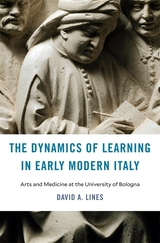 The Dynamics of Learning in Early Modern Italy: Arts and Medicine at the University of Bologna
David A. Lines
Harvard University Press, 2023 A pathbreaking history of early modern education argues that Europe’s oldest university, often seen as a bastion of traditionalism, was in fact a vibrant site of intellectual innovation and cultural exchange.
The University of Bologna was among the premier universities in medieval Europe and an international magnet for students of law. However, a long-standing historiographical tradition holds that Bologna—and Italian university education more broadly—foundered in the early modern period. On this view, Bologna’s curriculum ossified and its prestige crumbled, due at least in part to political and religious pressure from Rome. Meanwhile, new ways of thinking flourished instead in humanist academies, scientific societies, and northern European universities.
David Lines offers a powerful counternarrative. While Bologna did decline as a center for the study of law, he argues, the arts and medicine at the university rose to new heights from 1400 to 1750. Archival records show that the curriculum underwent constant revision to incorporate contemporary research and theories, developed by the likes of René Descartes and Isaac Newton. From the humanities to philosophy, astronomy, mathematics, and medicine, teaching became more systematic and less tied to canonical texts and authors. Theology, meanwhile, achieved increasing prominence across the university. Although this religious turn reflected the priorities and values of the Catholic Reformation, it did not halt the creation of new scientific chairs or the discussion of new theories and discoveries. To the contrary, science and theology formed a new alliance at Bologna.
The University of Bologna remained a lively hub of cultural exchange in the early modern period, animated by connections not only to local colleges, academies, and libraries, but also to scholars, institutions, and ideas throughout Europe.
The Dynamics of Lexical Interfaces
Ruth Kempson, Eleni Gregoromichelaki, Christine Howes
CSLI, 2011 Dynamic Syntax is a formal model of utterance description that attempts to articulate and substantiate the claim that human linguistic knowledge is essentially the ability to process language in context. The model provides an explicit demonstration of how interpretation is built up incrementally from the information provided by the words as they are encountered. Drawing from a range of analyses of natural language data, the authors use formal definitions, step-by-step derivations, and detailed lexical definitions to illustrate this new form of syntactic analysis and to show how the model can be applied to a broad range of constructions and languages.
 The Dynamics of Masters Literature: Early Chinese Thought from Confucius to Han Feizi
Wiebke Denecke
Harvard University Press, 2010 The importance of the rich corpus of “Masters Literature” that developed in early China since the fifth century BCE has long been recognized. But just what are these texts? Scholars have often approached them as philosophy, but these writings have also been studied as literature, history, and anthropological, religious, and paleographic records. How should we translate these texts for our times?
This book explores these questions through close readings of seven examples of Masters Literature and asks what proponents of a “Chinese philosophy” gained by creating a Chinese equivalent of philosophy and what we might gain by approaching these texts through other disciplines, questions, and concerns. What happens when we remove the accrued disciplinary and conceptual baggage from the Masters Texts? What neglected problems, concepts, and strategies come to light? And can those concepts and strategies help us see the history of philosophy in a different light and engender new approaches to philosophical and intellectual inquiry? By historicizing the notion of Chinese philosophy, we can, the author contends, answer not only the question of whether there is a Chinese philosophy but also the more interesting question of the future of philosophical thought around the world.
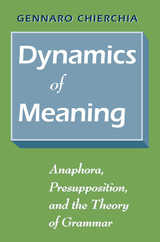 Dynamics of Meaning: Anaphora, Presupposition, and the Theory of Grammar
Gennaro Chierchia
University of Chicago Press, 1995 In The Dynamics of Meaning, Gennaro Chierchia tackles central issues in dynamic semantics and extends the general framework.
Chapter 1 introduces the notion of dynamic semantics and discusses in detail the phenomena that have been used to motivate it, such as "donkey" sentences and adverbs of quantification. The second chapter explores in greater depth the interpretation of indefinites and issues related to presuppositions of uniqueness and the "E-type strategy." In Chapter 3, Chierchia extends the dynamic approach to the domain of syntactic theory, considering a range of empirical problems that includes backwards anaphora, reconstruction effects, and weak crossover. The final chapter develops the formal system of dynamic semantics to deal with central issues of definites and presupposition. Chierchia shows that an approach based on a principled enrichment of the mechanisms dealing with meaning is to be preferred on empirical grounds over approaches that depend on an enrichment of the syntactic apparatus.
Dynamics of Meaning illustrates how seemingly abstract stances on the nature of meaning can have significant and far-reaching linguistic consequences, leading to the detection of new facts and influencing our understanding of the syntax/semantics/pragmatics interface.
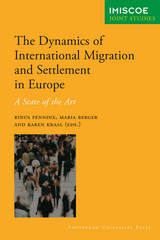 The Dynamics of Migration and Settlement in Europe: A State of the Art
Edited by Rinus Penninx
Amsterdam University Press, 2006
Between 1991 and 2001, the size of Britain’s ethnic minority population increased by a full fifty percent. In that same decade, approximately one million immigrants settled in Britain. Similar patterns of migration and settlement are taking place in other European countries, such as Germany and France.
The Dynamics of Migration and Settlement in Europe explores the causes and consequences of such massive changes in demography. Researchers at the IMISCOE–Network of Excellence (Immigration, Integration and Social Cohesion in Europe) bring together a wealth of theoretical and analytical research in this collection of essays addressing the many crucial questions that have arisen in the past two decades. Underlying these essays is a key concern for the healthy management of these new migration processes, as well as the eventual shape of the new societies that are just beginning to emerge.
International migration and the ensuing questions about integration continue to be subjects of intense debate, and this book will be welcomed among those involved in migration studies and international development.
The Dynamics of News and Indigenous Policy in Australia
Kerry McCallum and Lisa Waller
Intellect Books, 2017 This book offers rich insights into the news media’s role in the development of policy in Australia, and explores the complex and interactive relationship between news media and Australian Indigenous affairs.
Kerry McCallum and Lisa Waller critically examine how Indigenous health, bilingual education, and controversial legislation are portrayed through public media, and they look closely at how Indigenous people are both being excluded from policy and media discussion, as well as using the media to their advantage.
The Dynamics of Nuclear Proliferation
Stephen M. Meyer
University of Chicago Press, 1984 Stephen M. Meyer steps back from the emotions and rhetoric surrounding the nuclear arms debates to provide a systematic examination of the underlying determinants of nuclear weapons proliferation. Looking at current theories of nuclear proliferation, he asks: Must a nation that acquires the technical capability to manufacture nuclear weapons eventually do so? In an analysis, remarkable for its rigor and accessibility, Meyer provides the first empirical, statistical model explaining why particular countries became nuclear powers when they did. His findings clearly contradict the notion that the pace of nuclear proliferation is controlled by a technological imperative and show that political and military factors account for the past decisions of nations to acquire or forgo the development of nuclear weapons.
 The Dynamics of Performance Management: Constructing Information and Reform
Donald P. Moynihan
Georgetown University Press, 2008 Efficiency. Innovation. Results. Accountability. These, advocates claim, are the fruits of performance management. In recent decades government organizations have eagerly embraced the performance model—but the rush to reform has not delivered as promised. Drawing on research from state and federal levels, Moynihan illustrates how governments have emphasized some aspects of performance management—such as building measurement systems to acquire more performance data—but have neglected wider organizational change that would facilitate the use of such information. In his analysis of why and how governments in the United States have made the move to performance systems, Moynihan identifies agency leadership, culture, and resources as keys to better implementation, goal-based learning, and improved outcomes. How do governments use the performance information generated under performance systems? Moynihan develops a model of interactive dialogue to highlight how performance data, which promised to optimize decision making and policy change for the public's benefit, has often been used selectively to serve the interests of particular agencies and individuals, undermining attempts at interagency problem solving and reform. A valuable resource for public administration scholars and administrators, The Dynamics of Performance Management offers fresh insight into how government organizations can better achieve their public service goals.
Dynamics of Power in Dutch Integration Politics: From Accommodation to Confrontation
Justus Uitermark
Amsterdam University Press, 2012
Integration politics in the Netherlands has changed dramatically between 1990 and 2005. Whereas ethnic and religious differences were hitherto pacified through accommodation, a new and increasingly powerful current in Dutch politicsproblematizes the presence of minorities.This development represents a challenge to sociologists and political scientists: how to map and explain drastic changes?Arguing that extant approaches are better at explaining continuity than change, this book develops a distinct approach to the study of dynamic power relations to understand drastic transformations in the national debate as well as urban governance.
 The Dynamics of Rational Deliberation
Brian Skyrms
Harvard University Press, 1990 Brian Skyrms constructs a theory of “dynamic deliberation” and uses it to investigate rational decision-making in cases of strategic interaction. This illuminating book will be of great interest to all those in many disciplines who use decision theory and game theory to study human behavior and thought.
Skyrms begins by discussing the Bayesian theory of individual rational decision and the classical theory of games, which at first glance seem antithetical in the criteria used for determining action. In his effort to show how methods for dealing with information feedback can be productively combined, the author skillfully leads us through the mazes of equilibrium selection, the Nash equilibria for normal and extensive forms, structural stability, causal decision theory, dynamic probability, the revision of beliefs, and, finally, good habits for decision.
The author provides many clarifying illustrations and a handy appendix called “Deliberational Dynamics on Your Personal Computer.” His powerful model has important implications for understanding the rational origins of convention and the social contract, the logic of nuclear deterrence, the theory of good habits, and the varied strategies of political and economic behavior.
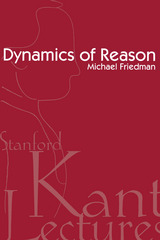 Dynamics of Reason
Michael Friedman
CSLI, 2001 This book introduces a new approach to the issue of radical scientific revolutions, or "paradigm-shifts," given prominence in the work of Thomas Kuhn. The book articulates a dynamical and historicized version of the conception of scientific a priori principles first developed by the philosopher Immanuel Kant. This approach defends the Enlightenment ideal of scientific objectivity and universality while simultaneously doing justice to the revolutionary changes within the sciences that have since undermined Kant's original defense of this ideal.
Through a modified Kantian approach to epistemology and philosophy of science, this book opposes both Quinean naturalistic holism and the post-Kuhnian conceptual relativism that has dominated recent literature in science studies. Focussing on the development of "scientific philosophy" from Kant to Rudolf Carnap, along with the parallel developments taking place in the sciences during the same period, the author articulates a new dynamical conception of relativized a priori principles. This idea applied within the physical sciences aims to show that rational intersubjective consensus is intricately preserved across radical scientific revolutions or "paradigm-shifts and how this is achieved.
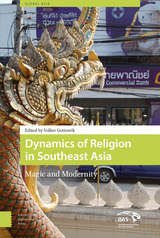 Dynamics of Religion in Southeast Asia: Magic and Modernity
Edited by Volker Gottowik
Amsterdam University Press, 2014 Modernity is surrounded by an almost magic aura that casts a spell over people all over the world. To connect with modernity, various ways and means are used, among them magic practices and religious ideas. Dynamics of Religion in Southeast Asia: Magic and Modernity deals with the magic in and of modernity and asks about its current significance for the dynamics of religion in Southeast Asia. Drawing on recent ethnographic research in this area, the contributors to this wide-ranging volume demonstrate how religious concepts contribute to meeting the challenges of modernity. Against this background, religion and modernity are no longer perceived as in contradiction; rather, it is argued that a revision of the western notion of religion is required to understand the complexity of 'multiple modernities' in a globalised world.. Dynamics of Religion in Southeast Asia: Magic and Modernity is part of the series Global Asia, published by Amsterdam University Press (AUP) in close collaboration with the International Institute for Asian Studies (IIAS)
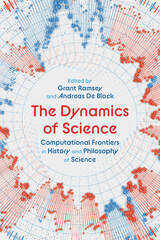 The Dynamics of Science: Computational Frontiers in History and Philosophy of Science
Grant Ramsey and Andreas De Block
University of Pittsburgh Press, 2022 Millions of scientific articles are published each year, making it difficult to stay abreast of advances within even the smallest subdisciplines. Traditional approaches to the study of science, such as the history and philosophy of science, involve closely reading a relatively small set of journal articles. And yet many questions benefit from casting a wider net: Is most scientific change gradual or revolutionary? What are the key sources of scientific novelty? Over the past several decades, a massive effort to digitize the academic literature and equip computers with algorithms that can distantly read and analyze a digital database has taken us one step closer to answering these questions. The Dynamics of Science brings together a diverse array of contributors to examine the largely unexplored computational frontiers of history and philosophy of science. Together, they reveal how tools and data from automated textual analysis, or machine “reading,” combined with methods and models from game theory and cultural evolutionary theory, can begin to answer fundamental questions about the nature and history of science.
Dynamics of Southwest Prehistory
Edited by Linda S. Cordell and George J. Gumerman
University of Alabama Press, 2006 Emerging from a School of American Research, this work reviews the general status of archaeological knowledge in 9 key regions of the Southwest to examine broader questions of cultural development, which affected the Southwest as a whole, and to consider an overall conceptual model of the prehistoric Southwest after the advent of sedentism.
 The Dynamics of Soviet Politics
Paul Cocks
Harvard University Press, 1976 The Dynamics of Soviet Politics is the result of reflective and thorough research into the centers of a system whose inner debates are not open to public discussion and review, a system which tolerates no public opposition parties, no prying congressional committees, and no investigative journalists to ferret out secrets. The expert authors offer an inside view of the workings of this closed system a view rarely found elsewhere in discussions of Soviet affairs. Their work, building as it does on the achievements of Soviet studies over the last thirty years, is firmly rooted in established knowledge and covers sufficient new ground to enable future studies of Soviet politics and social practices to move ahead unencumbered by stereotypes, sensationalism, or mystification.
Among the subjects included are: attitudes toward leadership and a general discussion of the uses of political history; the dramatic cycles of officially permitted dissent; the legitimacy of leadership within a system that has no constitutional provision for succession; the gradual adoption of Western-inspired administrative procedures and "systems management"; a study of group competition, and bureaucratic bargaining; Khrushchev's virgin-lands experiment and its subsequent retrenchment; the apolitical values of adolescents; the problems of integrating Central Asia into the Soviet system; a history of peaceful coexistence and its current importance in Soviet foreign policy priorities, and, finally, an overview of Soviet government as an extension of prerevolutionary oligarchy, with an emphasis on adaptation to political change.
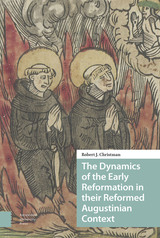 The Dynamics of the Early Reformation in their Reformed Augustinian Context
Robert Christman
Amsterdam University Press, 2020 On 1 July 1523, Johann van den Esschen and Hendrik Voes, two Augustinian friars from Antwerp, were burned on the Grand Plaza in Brussels, thereby becoming the first victims of the Reformation. Despite being well-known, the event barely registers in most Reformation histories. By tracing its origins and examining the impact of the executions on Martin Luther, on the Reformed Augustinian world, and on the early Reformation in the Low Countries and the German speaking lands, this study definitively demonstrates that the burnings were in fact the dénouement of broader trends within Late Medieval Reformed Augustinianism, as well as a watershed in the early Reformation. In doing so, it also reveals the central role played by the Augustinian friars of Lower Germany in shaping both the content and spread of the early Reformation, as well as Wittenberg’s influence on the events leading up to these first executions.
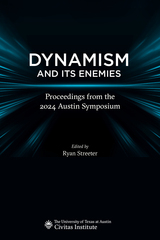 Dynamism and Its Enemies: Proceedings from the 2024 Austin Symposium
Edited by Ryan Streeter
University of Texas Press, 2025 Six scholars discuss dynamism, its benefits, and its obstacles. If we want more people in more places building and creating more good things, what should we do? This volume, edited by Ryan Streeter, presents perspectives on key issues of economic and societal dynamism by Ryan Decker (Federal Reserve), Ed Glaeser (Harvard University), Deirdre McCloskey (University of Illinois at Chicago), Edmund Phelps (Columbia University), Dan Shoag (Case Western Reserve University), and Cass Sunstein (Harvard Law School). The chapters in Dynamism and Its Enemies began as presentations at the 2024 Austin Symposium, a one-day seminar on dynamism in America hosted by the Civitas Institute at the University of Texas at Austin. This first annual event, held in one of America’s most dynamic cities, was designed to bring various leading scholars of dynamism’s various aspects into one place in order to think together about how to foster a more dynamic future.
 Dynamism: The Values That Drive Innovation, Job Satisfaction, and Economic Growth
Edmund Phelps, Raicho Bojilov, Hian Teck Hoon, and Gylfi Zoega
Harvard University Press, 2020 Nobel Laureate Edmund Phelps and an international group of economists argue that economic health depends on the widespread presence of certain values, in particular individualism and self-expression.
Nobel Laureate Edmund Phelps has long argued that the high level of innovation in the lead nations of the West was never a result of scientific discoveries plus entrepreneurship, as Schumpeter thought. Rather, modern values—particularly the individualism, vitalism, and self-expression prevailing among the people—fueled the dynamism needed for widespread, indigenous innovation. Yet finding links between nations’ values and their dynamism was a daunting task. Now, in Dynamism, Phelps and a trio of coauthors take it on.
Phelps, Raicho Bojilov, Hian Teck Hoon, and Gylfi Zoega find evidence that differences in nations’ values matter—and quite a lot. It is no accident that the most innovative countries in the West were rich in values fueling dynamism. Nor is it an accident that economic dynamism in the United States, Britain, and France has suffered as state-centered and communitarian values have moved to the fore.
The authors lay out their argument in three parts. In the first two, they extract from productivity data time series on indigenous innovation, then test the thesis on the link between values and innovation to find which values are positively and which are negatively linked. In the third part, they consider the effects of robots on innovation and wages, arguing that, even though many workers may be replaced rather than helped by robots, the long-term effects may be better than we have feared. Itself a significant display of creativity and innovation, Dynamism will stand as a key statement of the cultural preconditions for a healthy society and rewarding work.
 Dynastic Crisis and Cultural Innovation: From the Late Ming to the Late Qing and Beyond
David Der-wei Wang
Harvard University Press, 2005 This volume addresses cultural and literary transformation in the late Ming (1550-1644) and late Qing (1851-1911) eras. Although conventionally associated with a devastating sociopolitical crisis, each of these periods was also a time when Chinese culture was rejuvenated. Focusing on the twin themes of crisis and innovation, the seventeen chapters in this book aim to illuminate the late Ming and late Qing as eras of literary-cultural innovation during periods of imperial disintegration; to analyze linkages between the two periods and the radical heritage they bequeathed to the modern imagination; and to rethink the "premodernity" of the late Ming and late Qing in the context of the end of the age of modernism.
The chapters touch on a remarkably wide spectrum of works, some never before discussed in English, such as poetry, drama, full-length novels, short stories, tanci narratives, newspaper articles, miscellanies, sketches, familiar essays, and public and private historical accounts. More important, they intersect on issues ranging from testimony about dynastic decline to the negotiation of authorial subjectivity, from the introduction of cultural technology to the renewal of literary convention.
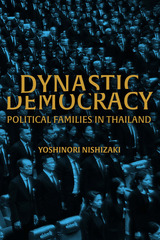 Dynastic Democracy: Political Families of Thailand
Yoshinori Nishizaki
University of Wisconsin Press, 2022 The political history of Thailand since the overthrow of absolute monarchy in 1932 has conventionally been interpreted as a long series of popular struggles for representative democracy and against military authoritarian rule. Yoshinori Nishizaki argues that this history can be better understood as one of struggles by elite political families for and against “dynastic democracy”—a form of democracy that is characterized by the patrimonial transmission of power between members of select ruling families. Dynastic Democracy suggests it is these familial-based contestations for political ascendancy that underlie the tumultuous politics of Thailand, a country that has experienced no fewer than twenty-two coups over the course of the past century.
Drawing extensively on Thai-language primary sources, including assets documents and cremation volumes for deceased politicians and their kin, Nishizaki traces the intricate blood and marriage connections among Thailand’s political families. These families may fall into two categories: influential commoner families that have held parliamentary seats since 1932 and form the core of Thailand’s dynastic democracy; and upper-class families that are kin to or aligned ideologically with the royal family and have repeatedly challenged dynastic democracy through coups, constitutional changes, and other political maneuvers. Nishizaki’s exploration of dynastic democracy illustrates how democratic pluralism in Thailand has been consistently stifled, to the detriment of ordinary citizens. Dynastic Democracy fleshes out a widely acknowledged yet heretofore empirically unsubstantiated facet of Thai political history—that in Thai politics, family matters.
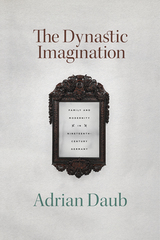 The Dynastic Imagination: Family and Modernity in Nineteenth-Century Germany
Adrian Daub
University of Chicago Press, 2021 Adrian Daub’s The Dynastic Imagination offers an unexpected account of modern German intellectual history through frameworks of family and kinship. Modernity aimed to brush off dynastic, hierarchical authority and to make society anew through the mechanisms of marriage, siblinghood, and love. It was, in other words, centered on the nuclear family. But as Daub shows, the dynastic imagination persisted, in time emerging as a critical stance by which the nuclear family’s conservatism and temporal limits could be exposed. Focusing on the complex interaction between dynasties and national identity-formation in Germany, Daub shows how a lingering preoccupation with dynastic modes of explanation, legitimation, and organization suffused German literature and culture.
Daub builds this conception of dynasty in a syncretic study of literature, sciences, and the history of ideas, engaging with remnants of dynastic ideology in the work of Richard Wagner, Émile Zola, and Stefan George, and in the work of early feminists and pioneering psychoanalysts. At every stage of cultural progression, Daub reveals how the relation of dynastic to nuclear families inflected modern intellectual history.
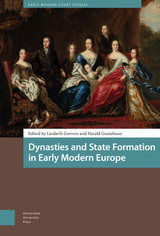 Dynasties and State Formation in Early Modern Europe
Liesbeth Geevers
Amsterdam University Press, 2023 In state formation research, princely houses have been a blind spot. The development of states has been discussed from many perspectives, like interstate competition, internal social conflicts, fiscal-military developments, etc., but at the centre of most European states, there was a princely house. These ruling houses have been overlooked in studies about state formation. What’s more, when discussing such dynasties, the vertical chronological perspective (grandfather-father-son) is all dominating, for instance in the focus on dynastic continuity, dynastic culture and representation, and the like. This collection of essays highlights the horizontal perspective (ruler, all children, siblings, cousins), in asking how the members of a princely family acted as a power network. The quest is to develop an understanding how this family network interplayed with other factors in the state formation process. This volume brings together existing knowledge of the topic with the aim of exchanging insights and furthering knowledge.
 Dysfluent in Fiction: Vocal Disability and Nineteenth-Century Literature
Riley McGuire
Ohio State University Press, 2025 In Dysfluent in Fiction, Riley McGuire unspools a literary history of vocal disability in the nineteenth century, arguing that this underexamined literary trope helps us to understand vocal hierarchies that still structure our present. Adopting the term “dysfluency” to show departure from normative expectations of pace, pitch, and fluency, McGuire reveals how dysfluent speech populates an enormous number of nineteenth-century texts and played a formative role in the lives of some of the period’s most influential writers. Dysfluent in Fiction examines anglophone literature during the long nineteenth century in both England and America by authors such as William Makepeace Thackeray, Charlotte Brontë, Lewis Carroll, Mary Elizabeth Braddon, and Frederick Douglass. Examples of dysfluencies across genres include lisping lovers, a baby-talking fairy, a mute detective, various disabilities in narratives of enslavement, and more. These representations show how disabled speech was both stigmatized and celebrated in ways that clarify our contemporary response to the spectrum of human articulation and that are a vocal corollary to current notions of neurodiversity. Dysfluency’s power, McGuire contends, lies in its denial that a single mode of articulation is possible, let alone desirable.
Dysfunction and Decentralization in New Media Art and Education
Robert W. Sweeny
Intellect Books, 2015 When using digital technologies, many types of dysfunction can occur, ranging from hardware malfunctions to software errors to human ineptitude. Many new media artworks employ various strategies of dysfunctionality in order to explore issues of power within societies and culture. When using digital technologies, many types of dysfunction can occur, from hardware malfunctions to software errors and human ineptitude. Robert W. Sweeney examines how digital artists have embraced the concept of the error or glitch as a form for freedom—imperfection or dysfunction can be an integral element of the project. In this book, he offers practical models and ideas for how artists and educators can incorporate digital technologies and integrate discussions of decentralized models of artistic production and education.
The Dysfunctional Workplace: Theory, Stories, and Practice
Seth Allcorn and Howard F. Stein
University of Missouri Press, 2015 This book explores an aspect of organizational life that is at times difficult to acknowledge and often painful to recall. Stories invite reflection and the development of greater understanding of organizational dynamics. This fresh scholarship provides a theoretical framework for discussion. Throughout this book, Allcorn and Stein utilize a psychoanalytically informed perspective to help readers understand why a leader, colleague or friend behaves in ways that are destructive of others and the organization and provides a basis for organizations to survive and thrive in a dysfunctional workplace.
Dyskolos
Menander
Harvard University Press
 Dyslexia and Development: Neuro-Biological Aspects of Extra-Ordinary Brains
Albert M. Galaburda
Harvard University Press, 1993 Dyslexia and Development presents the latest findings of neurobiological research, which suggest a link between seemingly minor brain abnormalities and epilepsy, learning disorders, and autism. The authors focus on the plasticity of the developing nervous system and the possible role of subtle early brain injury in the emergence of these disorders, particularly dyslexia.
The distinguished contributors to this volume examine epidemiological and clinical issues that may make the developing brain more vulnerable to environmental and genetic influences, which can in turn lead to abnormal brain plasticity and behavior. Although major forms of brain malformation have been clearly associated with functional deficits, mild forms have historically been ignored or trivialized; this book supports the hypothesis that several types of such malformation reflect brain injury during critical stages of development, and also the premise that more and more disturbances of thought and behavior stem from abnormalities of brain organization.
Neurologists and neurobiologists, psychologists, psycholinguists, psychiatrists, and special educators will find here a guide to more enlightened understanding and more effective treatment of dyslexia. In fact, the book emphasizes the positive aspect of the neurobiological deviation that dyslexic brains seem to show, along with the observation that people with such brains are often quite creative and extraordinary, rather than handicapped. In turn, the revised consideration of dyslexia should lead to more serious attention to other disturbances of childhood behavior as problems in developmental neurology, as well as to a deeper analysis of possible neurological bases for individual differences in normal behavior and personality.
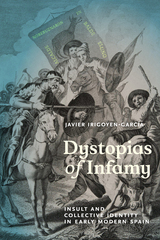 Dystopias of Infamy: Insult and Collective Identity in Early Modern Spain
Javier Irigoyen-García
Bucknell University Press, 2022 Insults, scorn, and verbal abuse—frequently deployed to affirm the social identity of the insulter—are destined to fail when that language is appropriated and embraced by the maligned group. In such circumstances, slander may instead empower and reinforce the collective identity of those perceived to be a threat to an idealized society. In this innovative study, Irigoyen-Garcia examines how the discourse and practices of insult and infamy shaped the cultural imagination, anxieties, and fantasies of early modern Spain. Drawing on sixteenth- and seventeenth-century literary works, archival research, religious and political literature, and iconographic documents, Dystopias of Infamy traces how the production of insults haunts the imaginary of power, provoking latent anxieties about individual and collective resistance to subjectification. Of particular note is Cervantes’s tendency to parody regulatory fantasies about infamy throughout his work, lampooning repressive law for its paradoxical potential to instigate the very defiance it fears.
|
|
